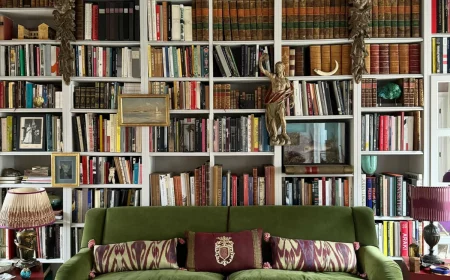Your Hallway is Probably Being Ignored. Here’s How to Fix It.
I’ve spent a lot of time in people’s homes, from cozy historic townhouses to big, brand-new builds in the suburbs. And after all these years in design, I can tell you a little secret: a home’s overall vibe often comes down to its hallways.
In this article
Yep, the hallways. They’re not just boring paths to get from the living room to the bedroom; they’re the spine of your house. They set the tone, manage the flow of everyday life, and give guests their first real impression. So many people treat them like an afterthought, a place for leftover decor. But honestly, that’s a huge missed opportunity. A well-designed hallway isn’t just prettier—it can solve real problems like storage and lighting.
A long, empty hall can feel intimidating, I get it. But let’s look at it like a pro. This guide will walk you through the practical stuff—the real techniques that make a hallway work for you and your family.
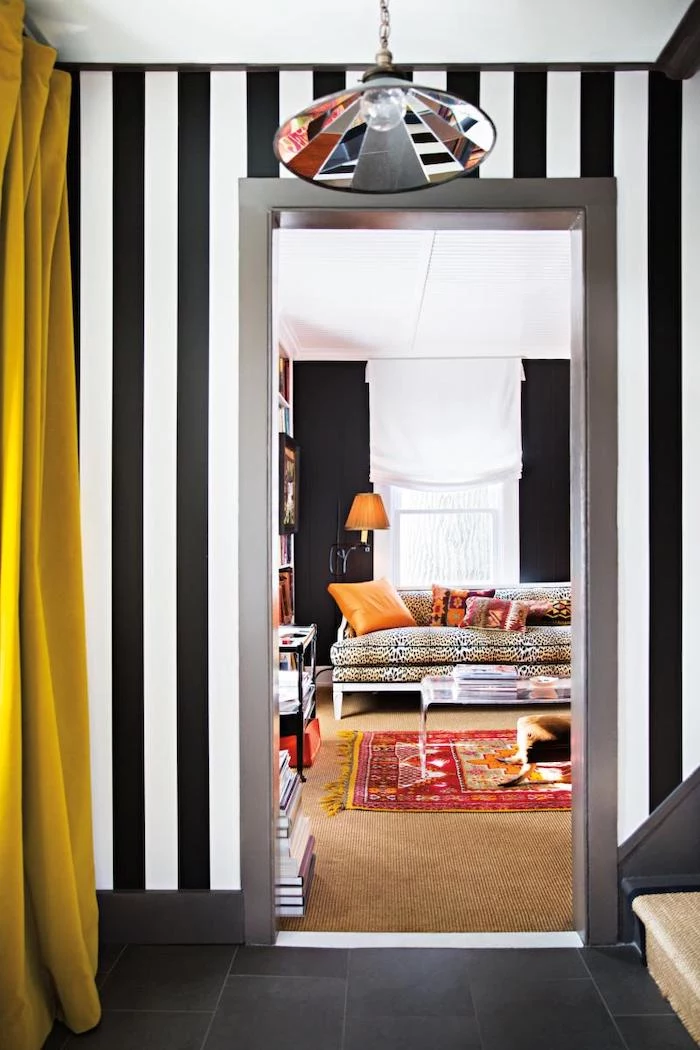
First, Let’s Talk About the Vibe of the Space
Before you even think about paint colors or furniture, you have to understand the space itself. Hallways are unique little ecosystems governed by light, space, and even sound. Getting these basics right is the foundation for everything else, and skipping this step is where most designs go wrong.
Light is Your Best Friend in a Narrow Hall
Hallways are often the darkest parts of a home, so light is your most powerful tool. How you use it determines whether the space feels bright and airy or like a cramped tunnel. The magic trick here is something called Light Reflectance Value, or LRV. Every paint color has an LRV score from 0 (jet black) to 100 (pure white), telling you exactly how much light it bounces back. You can find it on the back of the paint chip or on the manufacturer’s website.
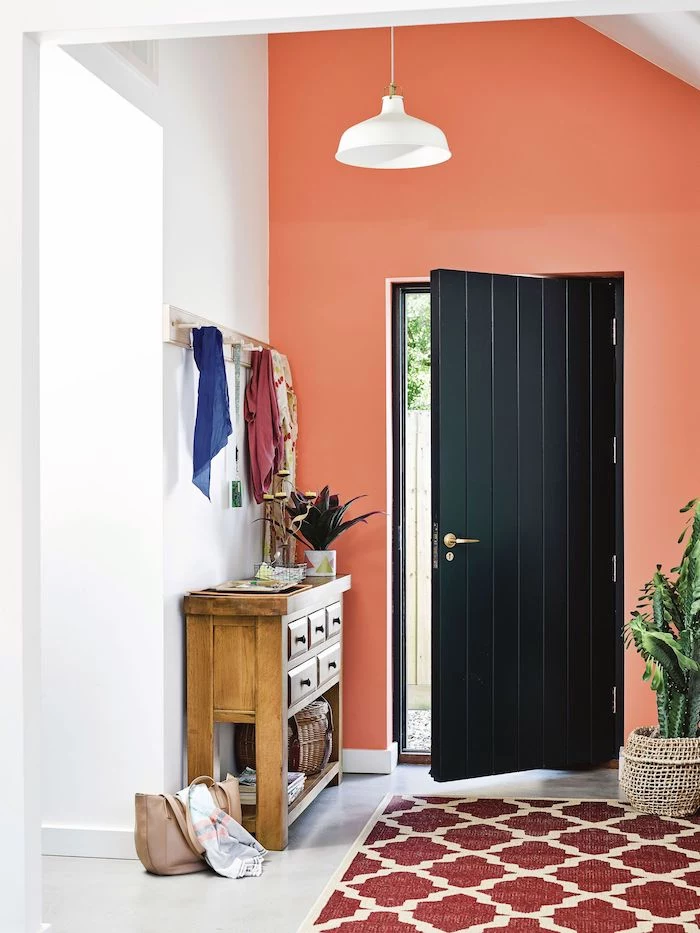
For most hallways, I always suggest sticking with paints that have an LRV of 60 or higher. A paint with an LRV of 75, for example, will reflect a whopping 75% of the light that hits it, making the space feel way bigger and brighter. To give you a starting point, check out popular choices like Benjamin Moore’s ‘Chantilly Lace’ (LRV 92.2) or Sherwin-Williams’ ‘High Reflective White’ (LRV 93). They’re decorator favorites for a reason!
By the way, the paint finish matters, too. High-gloss looks glam but reflects light like a mirror, highlighting every single bump and imperfection on the wall. A flat or matte finish is lovely and soft, but it’s a nightmare to clean. I learned this the hard way once when we used a gorgeous matte paint in a family’s main hall. It looked amazing for about five minutes. Six months later, it was covered in scuffs and fingerprints that were impossible to wash off. The sweet spot for a high-traffic area like a hallway is an eggshell or satin finish. It has a soft glow and is durable enough to be wiped down.

Give Yourself Room to Breathe: The 36-Inch Rule
A hallway needs to be functional above all else, which means people have to be able to move through it without turning sideways. The golden rule, based on accessibility guidelines, is to maintain a minimum clear width of 36 inches (about 91 cm). This isn’t just for wheelchairs; it’s what allows two people to pass by each other or lets you carry a laundry basket without smacking your knuckles.
Here’s a little challenge: Pause right now. Go grab a tape measure and check the width of your main hallway. Do you have 36 inches of clear space? If you’re thinking of adding a console table or a bench, make sure it doesn’t intrude into that zone. If your hallway is already narrow (say, under 42 inches wide), I’d strongly advise against adding any furniture that sits on the floor.
Stop the Echo: Managing Sound in a Tunnel
Hallways are basically echo chambers. All those hard surfaces—wood floors, bare walls—bounce sound around, making footsteps and conversations sound way louder than they are. This gets really annoying in a two-story home, where noise from a downstairs hall can travel right up into the bedrooms.
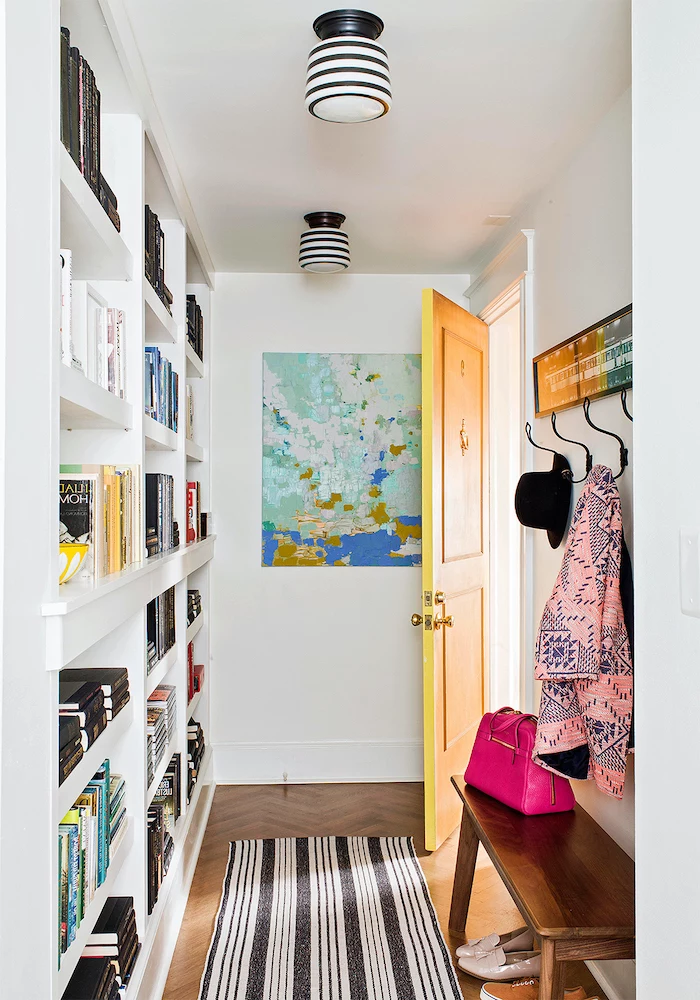
The easiest fix? A runner. A good-quality wool or thick synthetic rug laid over a felt pad will absorb a surprising amount of sound. Wall treatments are another great option. Things like grasscloth wallpaper, fabric panels, or even a big tapestry can help dampen the echo. Even a gallery wall of framed art helps break up those flat, reflective surfaces.
The Bones of Your Hallway: Floors and Walls
Okay, with the principles sorted, let’s talk about the big surfaces. Your choices for flooring and walls have the biggest impact on how your hallway holds up over time. I always tell people to put their money into quality foundational materials because they are the hardest and most expensive to change later.
Picking the Right Floor for Heavy Traffic
Hallway flooring gets absolutely punished. It sees all the foot traffic, dirt, and wet shoes. Durability should be your number one priority here. Let’s break down the most common options:
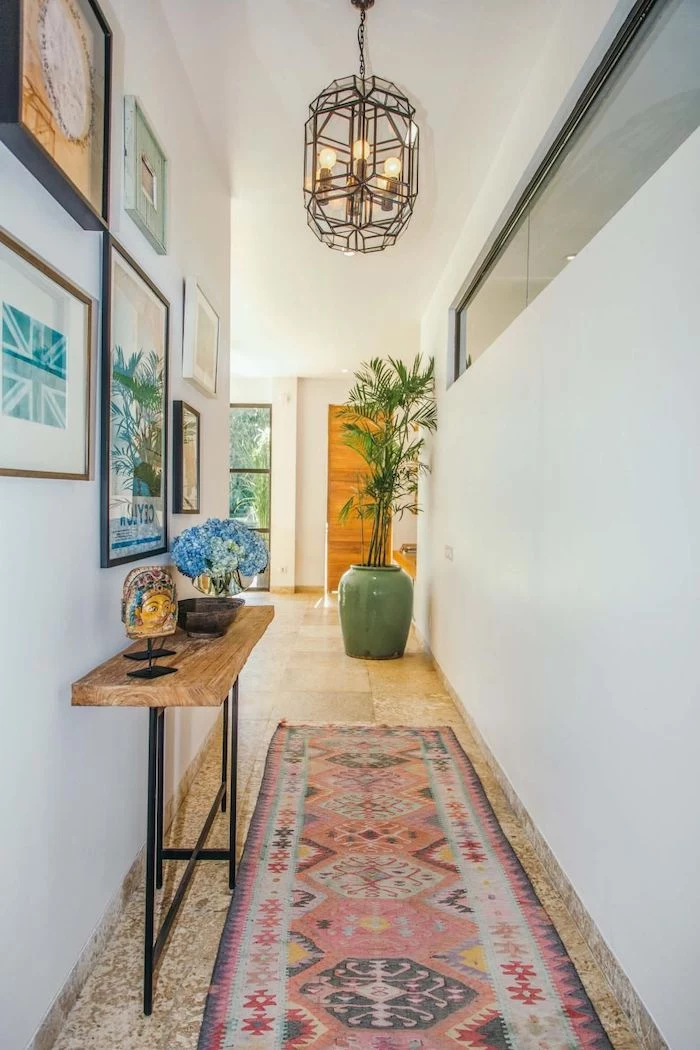
- Hardwood: A classic for a reason. It’s warm and beautiful, but you’ll want a durable species like oak. Softer woods like pine will get dented and scratched up in no time. Pro tip: Run the boards along the length of the hallway to make it feel longer. Hardwood is a bigger investment, often in the $$$$ price range, and installation is best left to the pros.
- Porcelain or Ceramic Tile: This stuff is tough as nails and perfect for wet or muddy entryways. When you’re shopping for tile, look for its PEI rating, which scores durability from 1 to 5. For a hallway, you need a tile with a PEI of at least 3, but preferably 4. I once had a client who fell in love with a gorgeous decorative tile with a PEI of 1. It started cracking within a year. A costly mistake! Tile is more of a mid-range cost ($$$) and a medium-difficulty DIY.
- Luxury Vinyl Tile (LVT): Honestly, LVT is a fantastic modern choice, especially for families with kids or pets. It’s waterproof, scratch-resistant, and a little softer underfoot than tile. It’s also one of the most budget-friendly options ($$) and is very DIY-friendly. You can find great options at specialty flooring stores, but also check out places like Floor & Decor or online retailers like Wayfair.
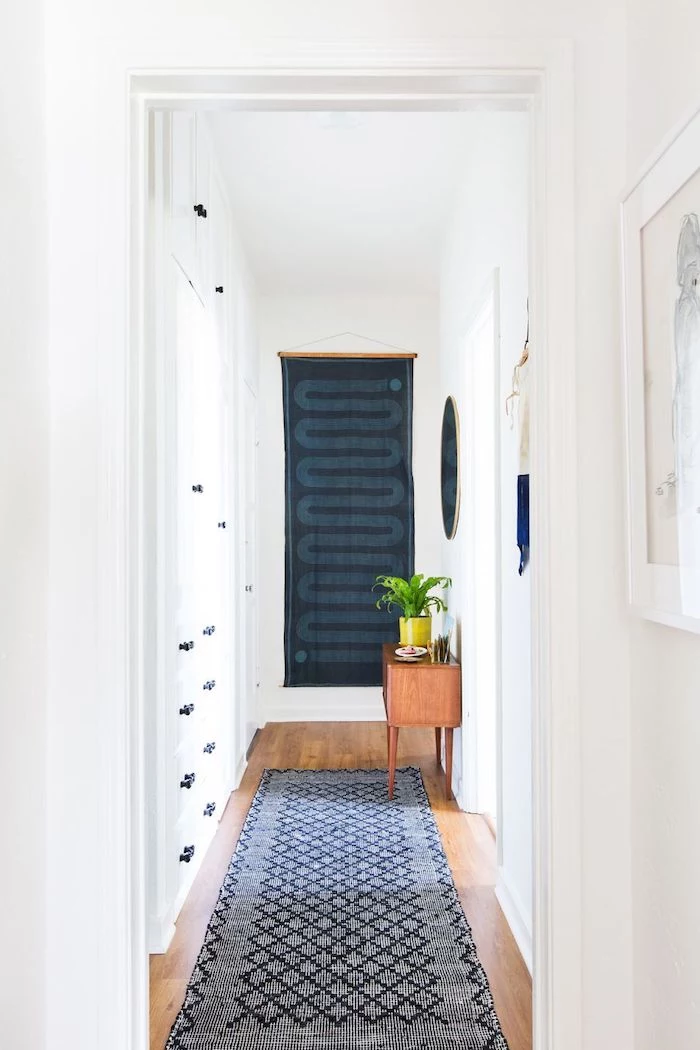
Wall Treatments That Can Take a Beating
Hallway walls are magnets for scuffs from bags, shoulders, and furniture. A good scrubbable paint is your first line of defense, but adding some architectural detail offers both protection and style.
- Wainscoting or Beadboard: This is a traditional solution where you panel the lower third of the wall. It’s usually painted in a durable semi-gloss trim paint, creating a tough surface right where the damage happens. Installing it properly is a solid weekend project for a handy person, but the classic character it adds is well worth the effort.
- Durable Wallpaper: Modern vinyl or grasscloth wallpapers are incredibly tough and can add amazing texture and pattern. But a word of caution: installation is everything. Unless you’re very experienced, I’d recommend hiring a professional paperhanger. A bad seam can ruin the whole look, and you don’t want to waste money on expensive paper.
Let There Be (Good) Light
A single, sad ceiling light just won’t cut it. Good lighting can completely transform a hallway. The strategy the pros use is called layering, which means combining different types of light.
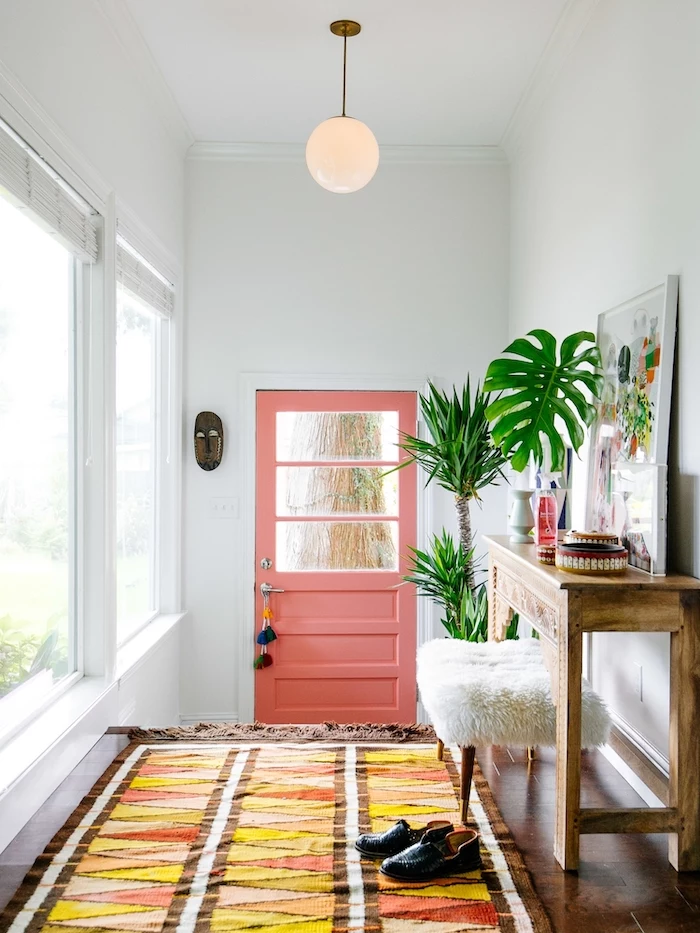
- Ambient Light: This is your general, overall lighting. For a long hall, a series of flush-mount fixtures or recessed lights spaced every 8-10 feet is ideal. If you have high ceilings, a row of pendants can be a showstopper. And ALWAYS put them on a dimmer switch. It’s a cheap upgrade that lets you control the mood.
- Task Light: This is focused light for doing things. Think of a pair of wall sconces flanking a mirror—perfect for a last-minute check before you leave. Place the center of the sconces around eye level (60-66 inches from the floor) to avoid weird shadows. A small lamp on a console table is another great example.
- Accent Light: This is the fun stuff, used to highlight artwork or architectural details. A dedicated picture light over a favorite painting makes it feel special. Another cool trick is using low-level lights installed a few inches off the floor to wash the walls, creating a beautiful effect that also doubles as a nightlight.
Heads up! While swapping an existing light fixture might be a DIY job if you know your way around a circuit breaker, installing a new dimmer switch or running new wiring is 100% a job for a licensed electrician. Don’t risk it!
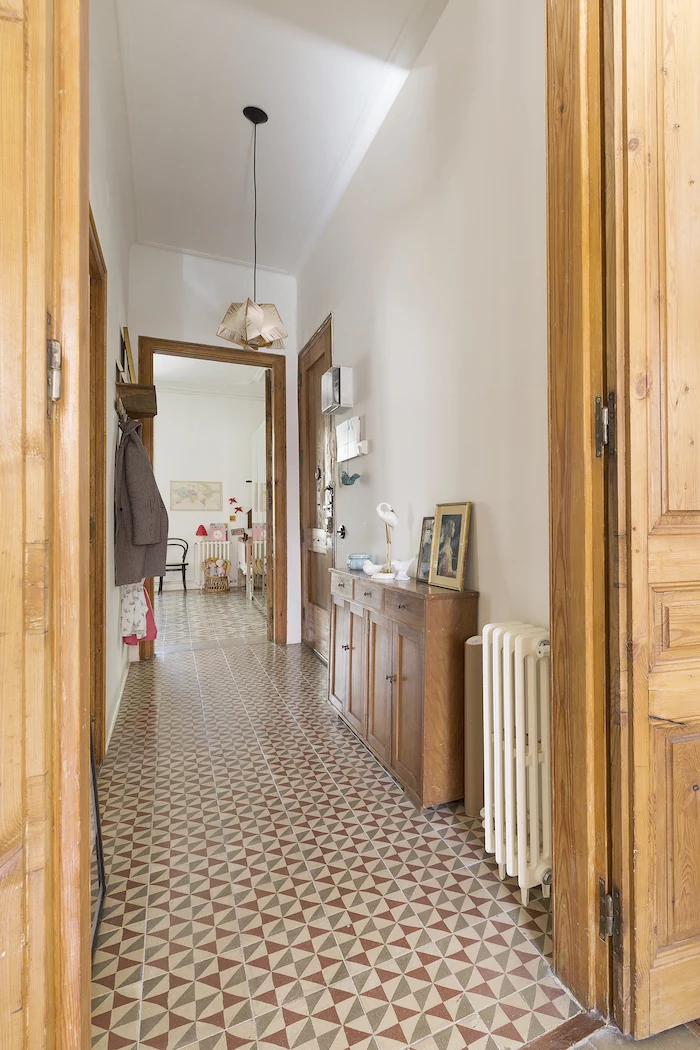
Furnishings That Actually Work
The key to furnishing a hallway is choosing pieces with the right scale and a clear purpose. Every item should either solve a problem or look amazing, all without blocking the path.
The Humble Console Table
A slim console table is the classic hallway workhorse—a landing strip for keys, mail, and your bag. The biggest mistake people make is choosing one that’s too deep. Look for a console that’s no more than 12-14 inches deep. You can expect to pay anywhere from $150 for a simple one at a big-box store to $800+ for a higher-end piece. A floating console is an even better option for tight spaces since it keeps the floor clear. A custom floating piece might run you $1,000-$2,500, but it’s a perfect solution for a tricky spot.
The Mighty Bench
A bench is great for sitting down to take off shoes. Look for one with built-in storage, like a lift-up top or room for baskets underneath. It’s the perfect spot to stash shoes, hats, and mittens, keeping clutter out of sight.
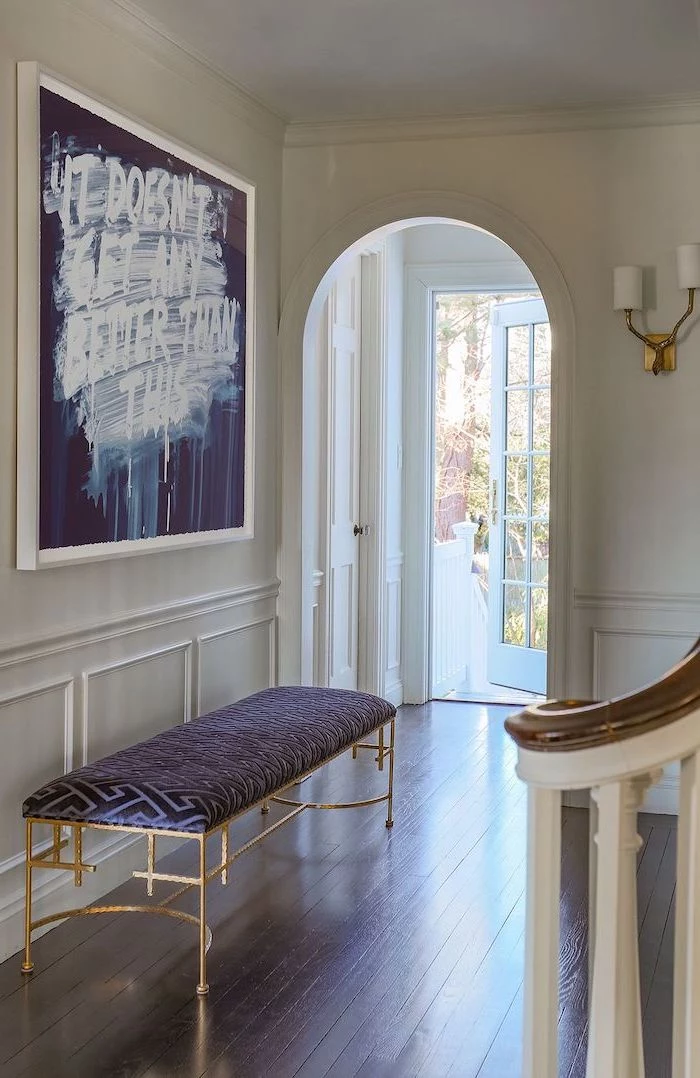
Using Mirrors Smartly
Mirrors are magic in hallways; they bounce light and create an illusion of space. Just be careful with placement. Putting a big mirror at the very end of a long, narrow hall can create a weird, disorienting “endless tunnel” effect. It’s usually better to place it on a long wall to make the hallway feel wider.
The Ultimate Fix: Custom Built-Ins
If you have the budget, custom built-in storage is the absolute best solution. This is a pro job where a skilled carpenter creates storage tailored to your exact space. You can incorporate a bench, hooks, and cabinets, all painted the same color as the walls to blend in seamlessly. To be frank, this is a significant investment—expect to spend anywhere from $3,000 to $10,000+ depending on the size and complexity. But it permanently solves storage problems and adds serious value to your home.
The Final Touches That Bring It to Life
With the big stuff in place, this is where you add your personality.
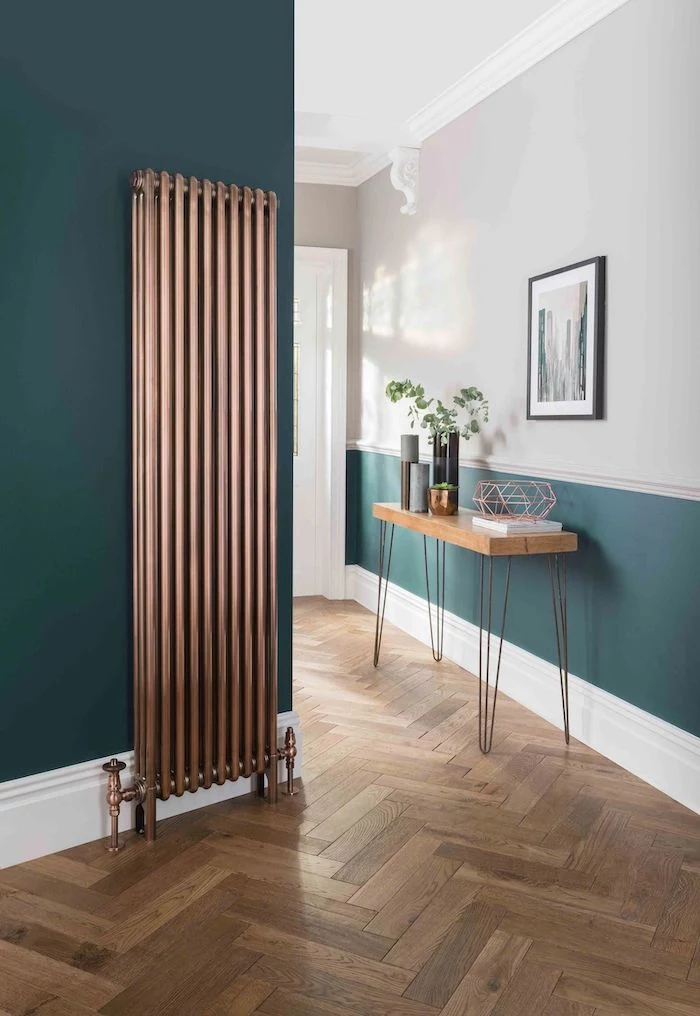
How to Hang a Gallery Wall Without Losing Your Mind
A gallery wall is a fantastic way to display family photos or art. To avoid turning your wall into swiss cheese, use the paper template method. Trace each frame onto kraft paper, cut it out, and use painter’s tape to arrange the paper shapes on the wall. You can move them around until the layout feels perfect. As a general rule, hang art so its center is about 57 inches from the floor—average eye level.
Quick tip! Here’s your gallery wall shopping list:
– Kraft paper (or newspaper)
– Painter’s tape
– Measuring tape
– A level
– Picture hooks and a hammer
Having it all ready before you start is half the battle!
Choosing a Runner That Lasts
A runner adds color, texture, and comfort. For material, wool is the gold standard because it’s durable and naturally stain-resistant. But good synthetics like polypropylene are also excellent, budget-friendly choices for high-traffic zones. The most important part? A high-quality rug pad. It stops the rug from slipping (a major tripping hazard) and extends its life.
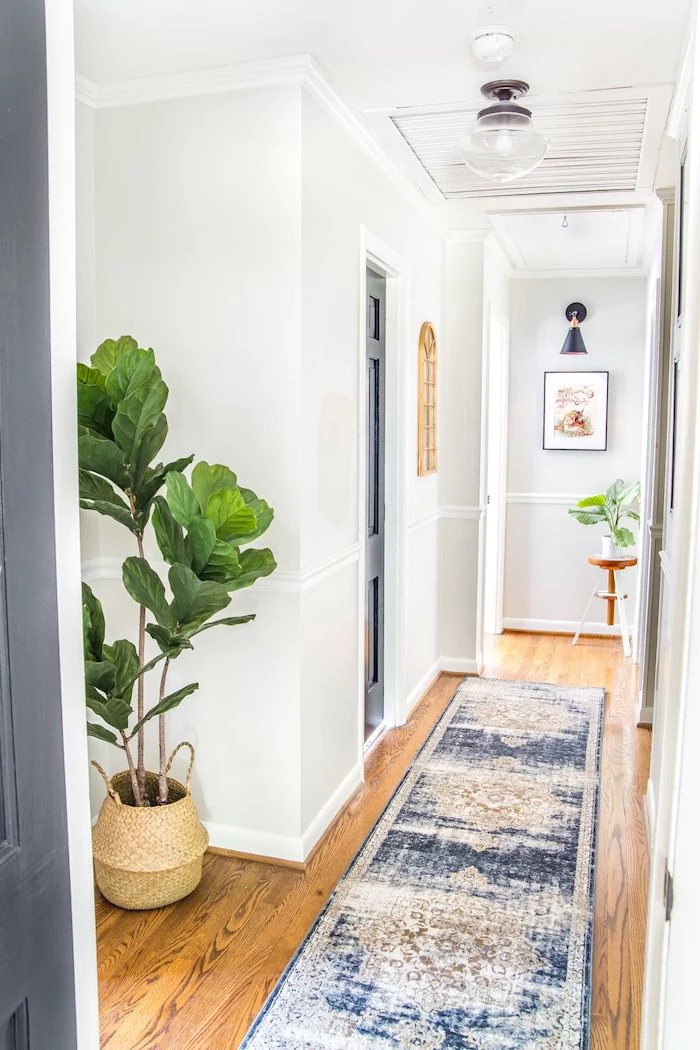
The Best Plants for Dark Corners
A little greenery is always a good idea, but you have to choose plants that can handle low light. A hallway with no direct sun is no place for a succulent. Instead, look for tough guys like the ZZ plant, the snake plant, or the cast iron plant. They’re famous for surviving low light and a bit of neglect.
Need a Fast Fix? Try This 1-Hour Hallway Refresh
Short on time and cash? Here’s a quick win. First, buy the best quality runner you can afford with a good pad—it will instantly add warmth and style. Second, swap the lightbulbs in your existing fixture for brighter, higher-lumen LEDs in a warm white temperature (around 2700K-3000K). Instant impact for very little effort!
A Final Word on Safety and When to Call a Pro
Your hallway has to be safe. It’s an escape route in an emergency, so building codes require it to be clear. Never, ever block it. Watch out for tripping hazards like rug corners or low decor.
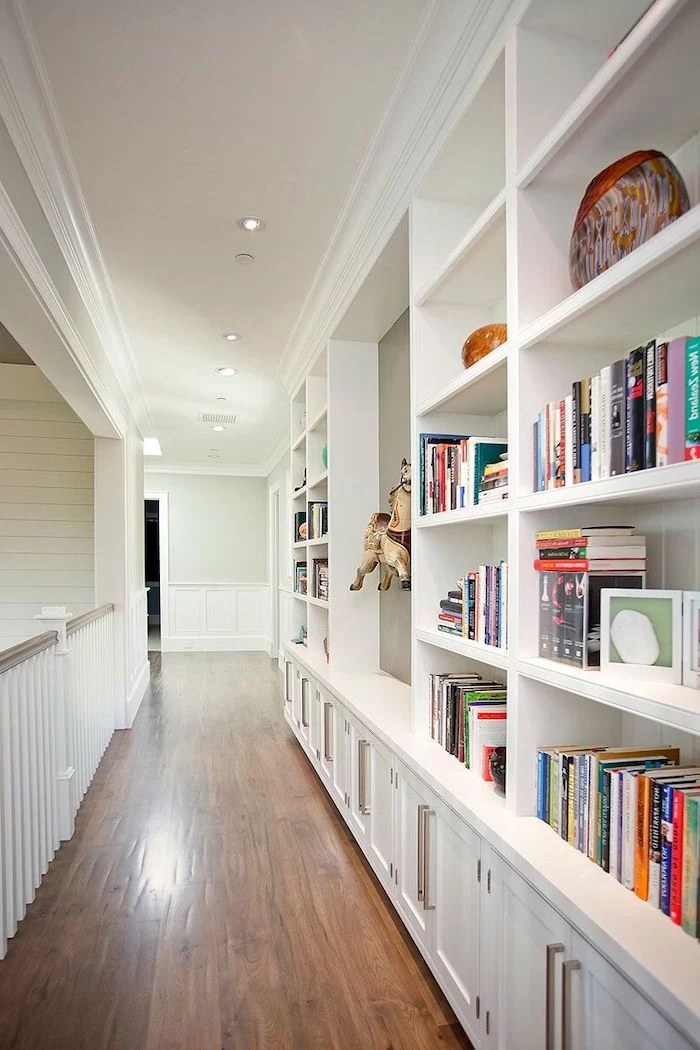
And while many of these ideas are DIY-friendly, know your limits. Any work involving electrical wiring, moving walls, or plumbing requires a licensed and insured professional. Trying to do it yourself isn’t just dangerous; it can void your homeowner’s insurance. Investing in a pro for the complex stuff ensures the work is done safely, to code, and will stand the test of time. It’s always the right call.
Inspirational Gallery
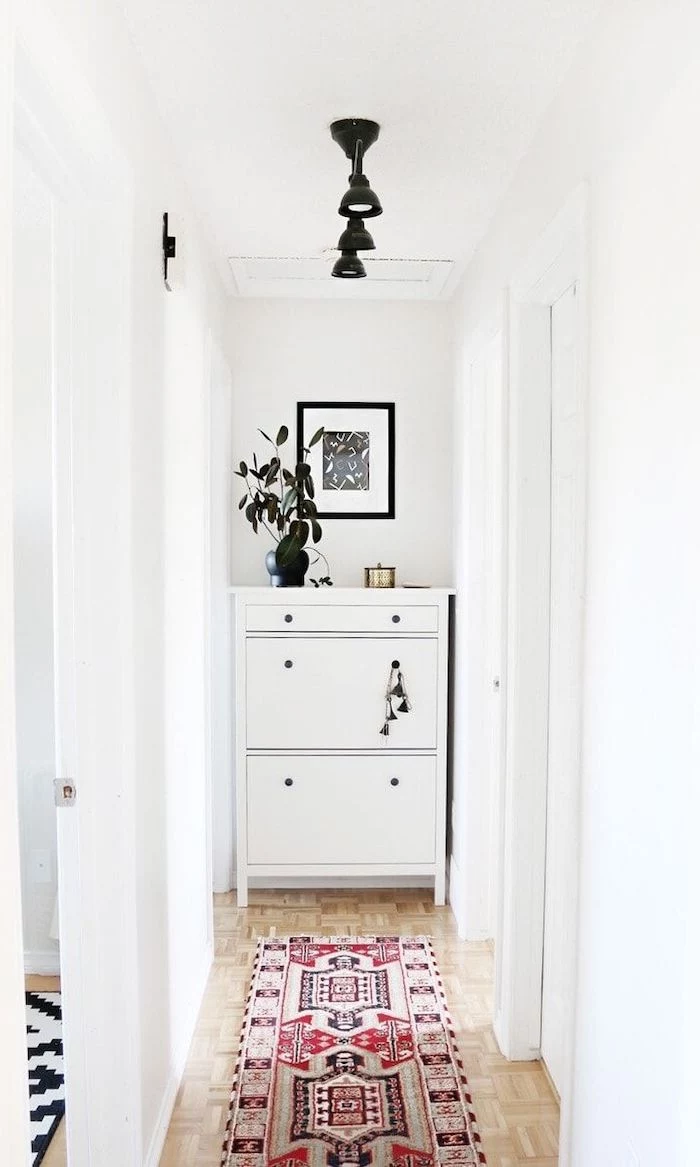
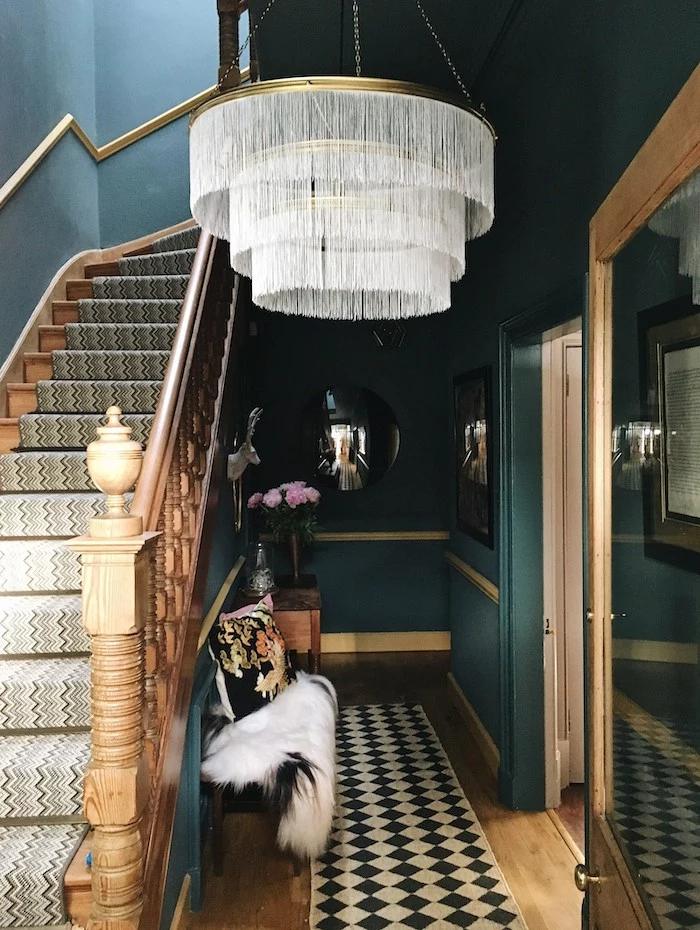
The biggest runner rug mistake: Choosing one that’s too small. Your runner should have about 4-5 inches of bare floor showing on each side and should not press against the walls. This creates a more intentional, generous look, rather than a tiny strip floating in a sea of floor.
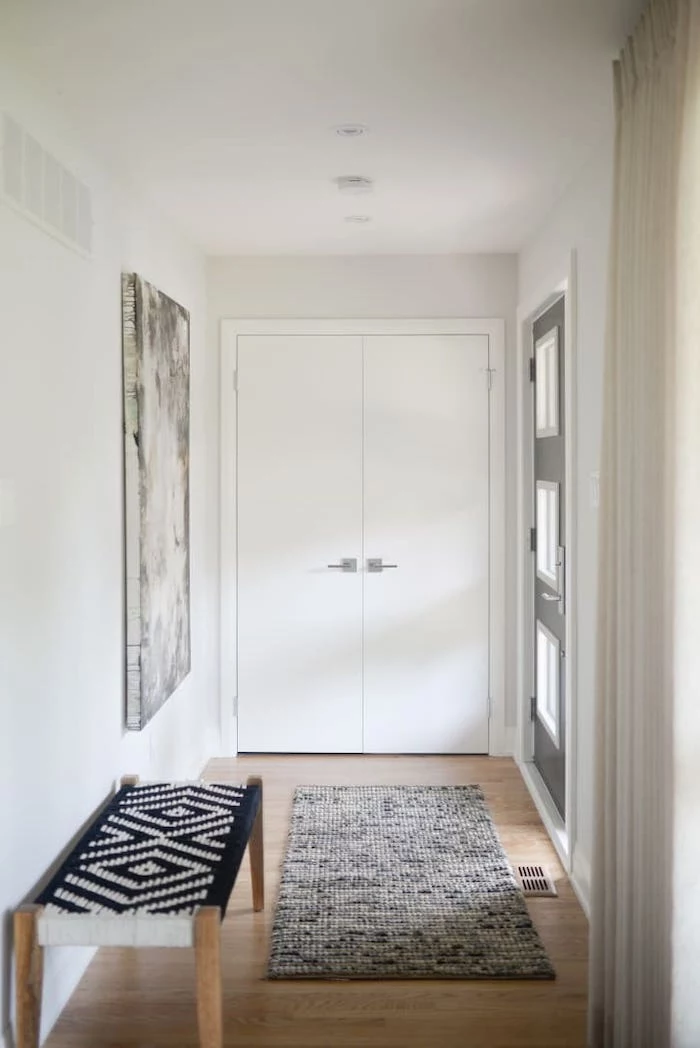
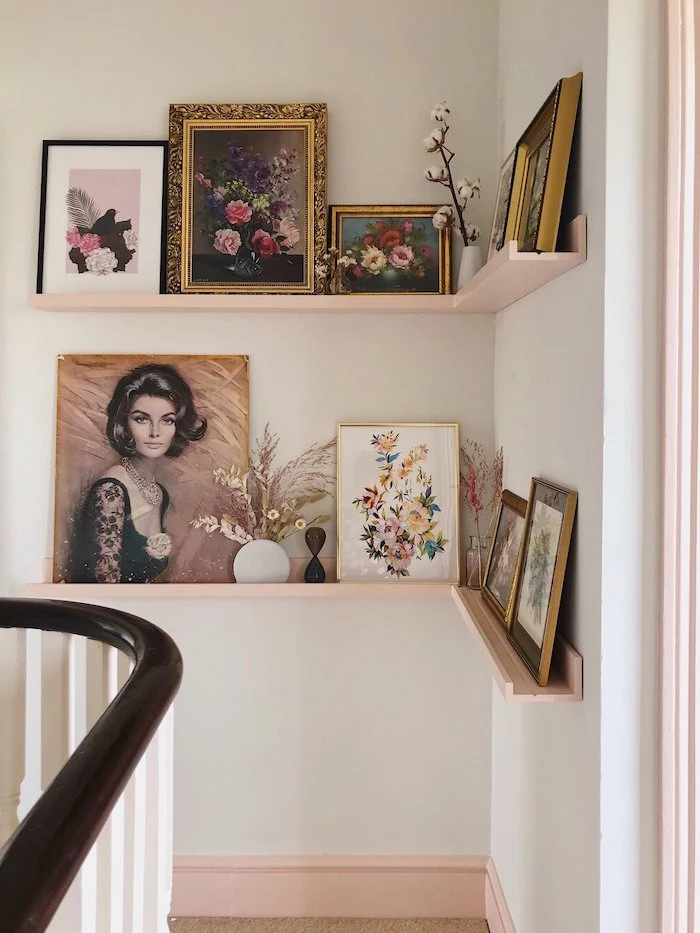
Consider the scent of your entryway. This is the first sensory impression of your home. A simple reed diffuser with a subtle, clean scent like sandalwood or white tea—nothing too overpowering—can create an immediate sense of calm and welcome. Brands like NEST New York or P.F. Candle Co. offer elegant options that double as decor.
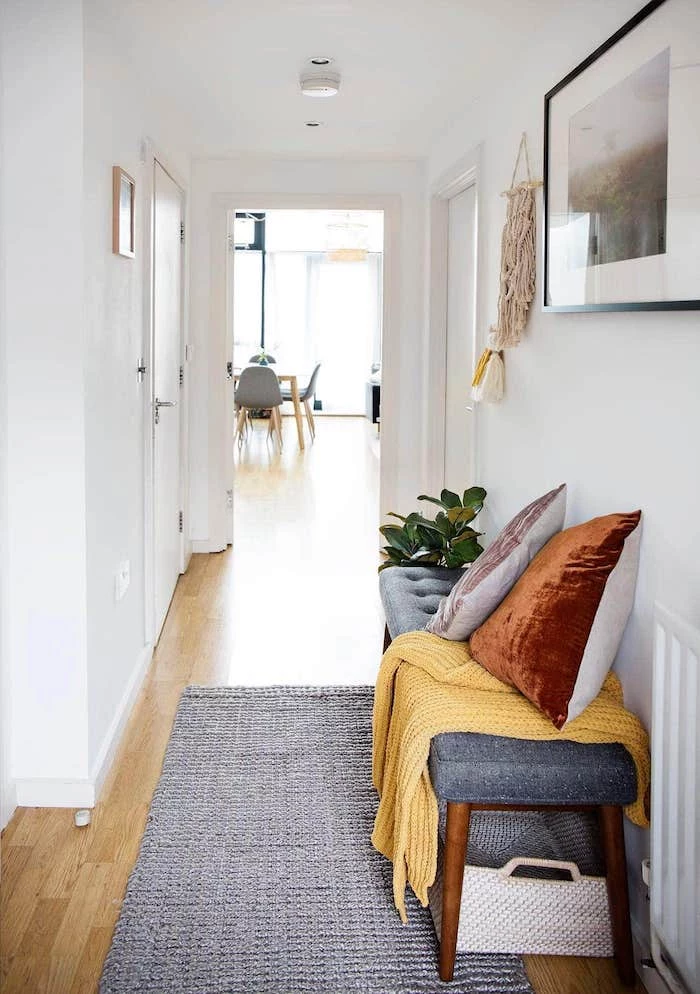
- Group art with a common theme, like black-and-white photography or botanical prints.
- Lay out your arrangement on the floor first to perfect the spacing.
- Keep the center of the entire grouping at eye level (around 57 inches from the floor).
The secret to a stunning gallery wall? Cohesion and planning.
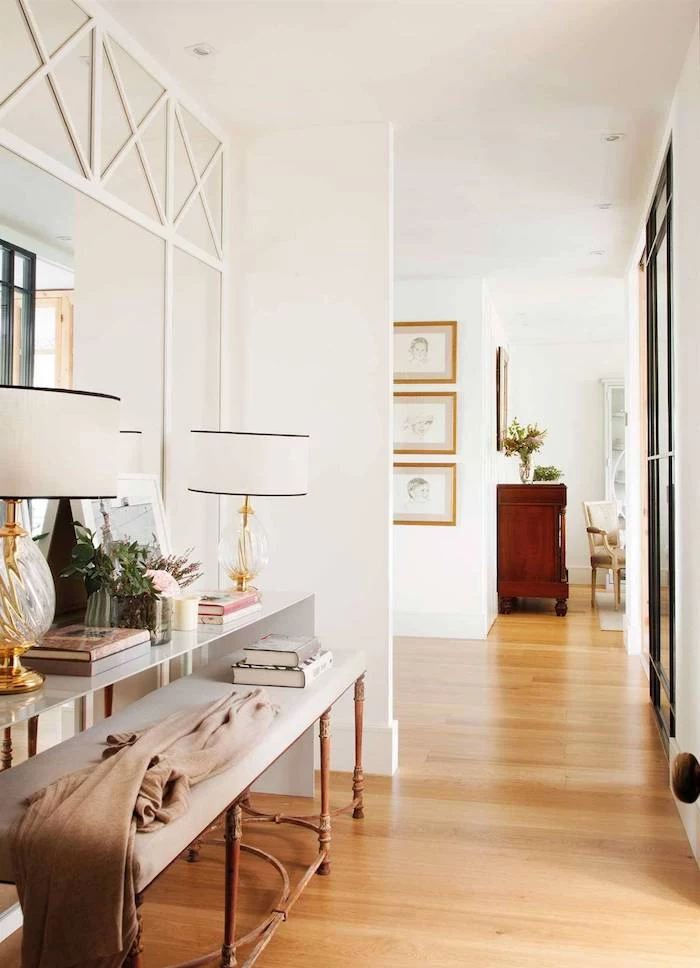
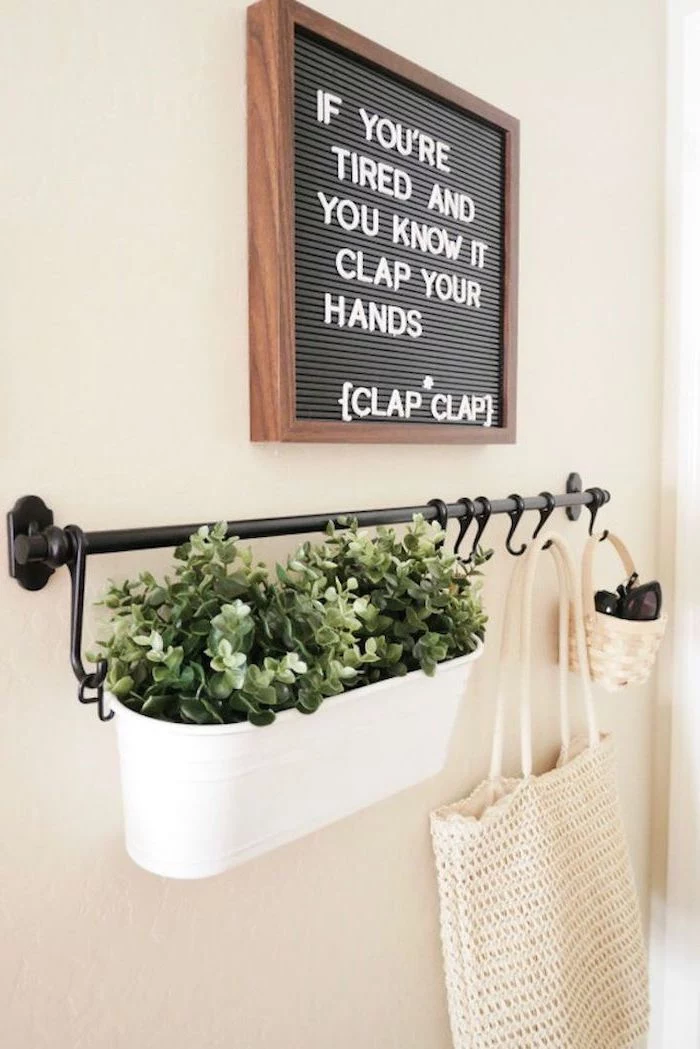
A well-placed mirror doesn’t just show your reflection; it steals light from other rooms and throws it into the dark corners of your hall.
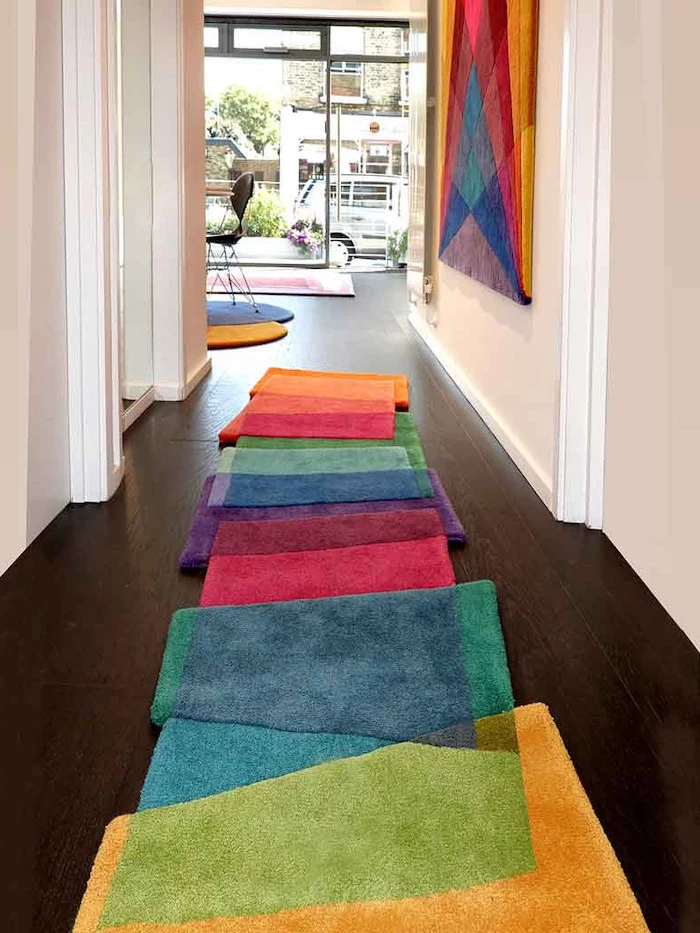
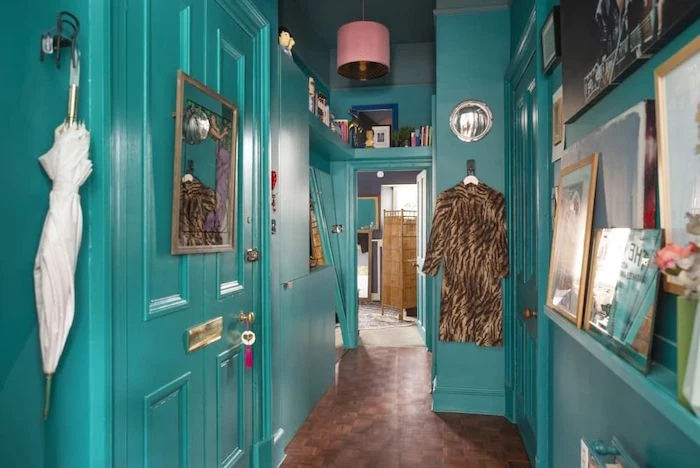
Satin/Semi-Gloss Finish: Highly durable and easy to clean, making it ideal for high-traffic hallway walls that get scuffs and fingerprints. It has a noticeable sheen.
Eggshell/Matte Finish: Offers a more modern, velvety look that hides imperfections well but is less resistant to scuffs. Best for low-traffic hallways or above a dado rail.
For most families, a quality satin like Benjamin Moore’s Scuff-X is the perfect blend of resilience and style.
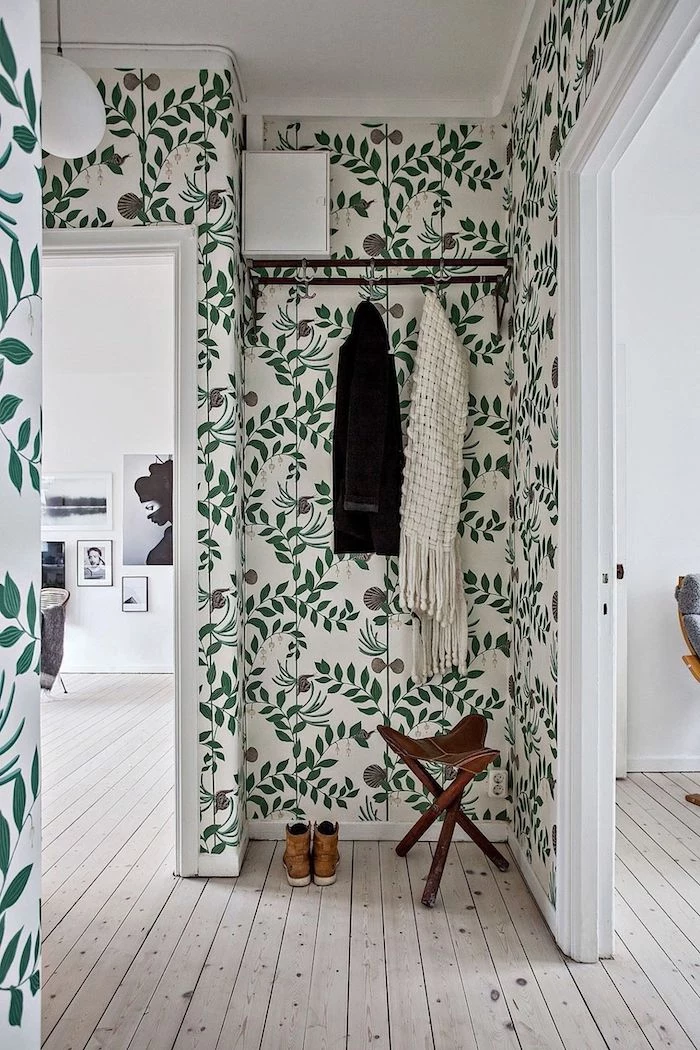
Styling a console table is an art of balance. Follow the
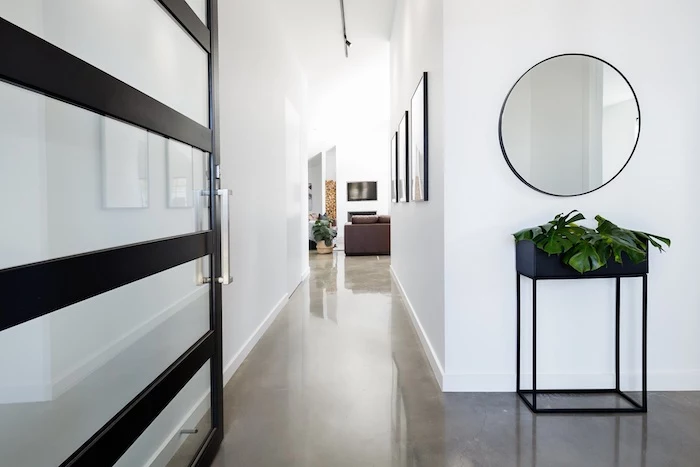
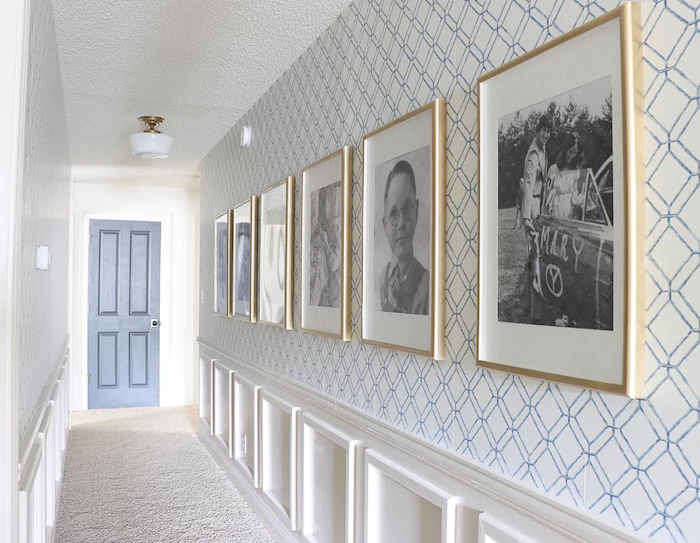
What’s the one piece that can instantly elevate a boring hallway?
A statement light fixture. Swap out that generic flush-mount for a sculptural pendant or a small chandelier. It draws the eye upward, adds personality, and serves as a piece of art in itself. Look at brands like Cedar & Moss or Rejuvenation for timeless, high-impact options.

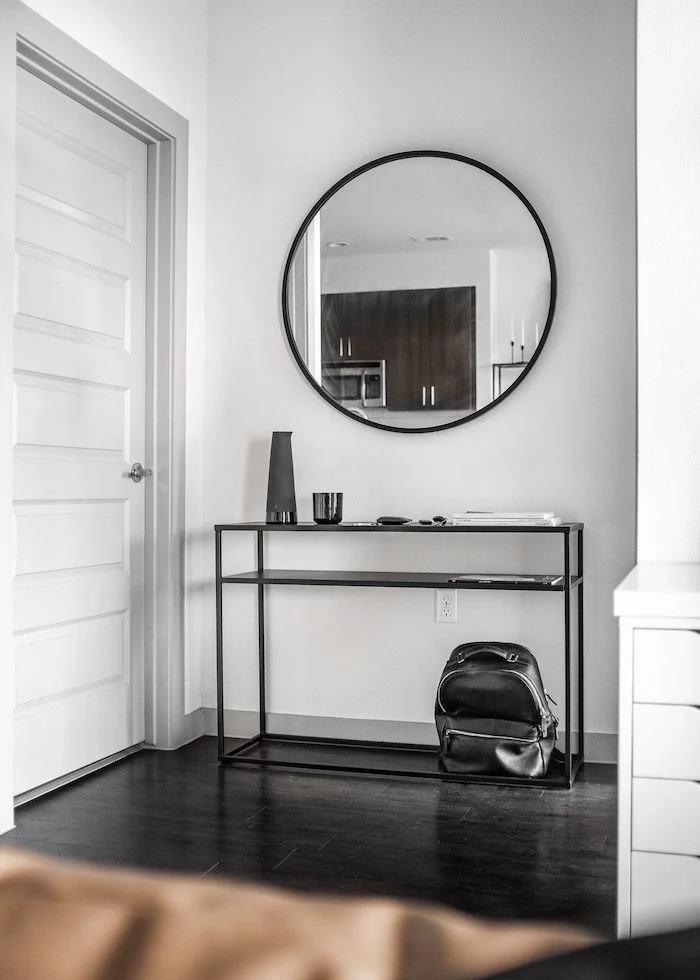
The average person takes over 2,000 steps per day inside their home, with hallways bearing the brunt of this traffic.
This is why flooring choice is critical. Luxury Vinyl Tile (LVT) is a champion here, offering the look of real wood or stone with superior scratch and water resistance. Unlike traditional hardwood, it won’t warp from wet shoes or get easily damaged by kids and pets.
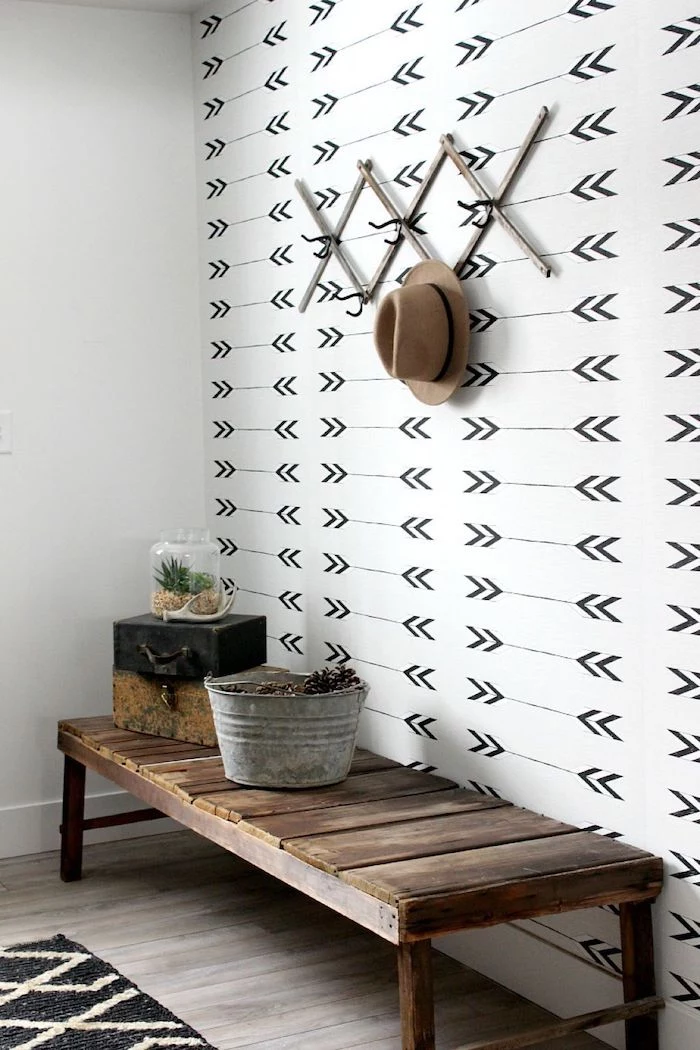
- Use picture ledges to display art and objects without dozens of nail holes.
- Install tall, narrow shelving units like the IKEA BILLY to draw the eye up.
- Hang a single, oversized piece of art to create a dramatic focal point.
The trick to making a narrow hall feel grander? Go vertical.

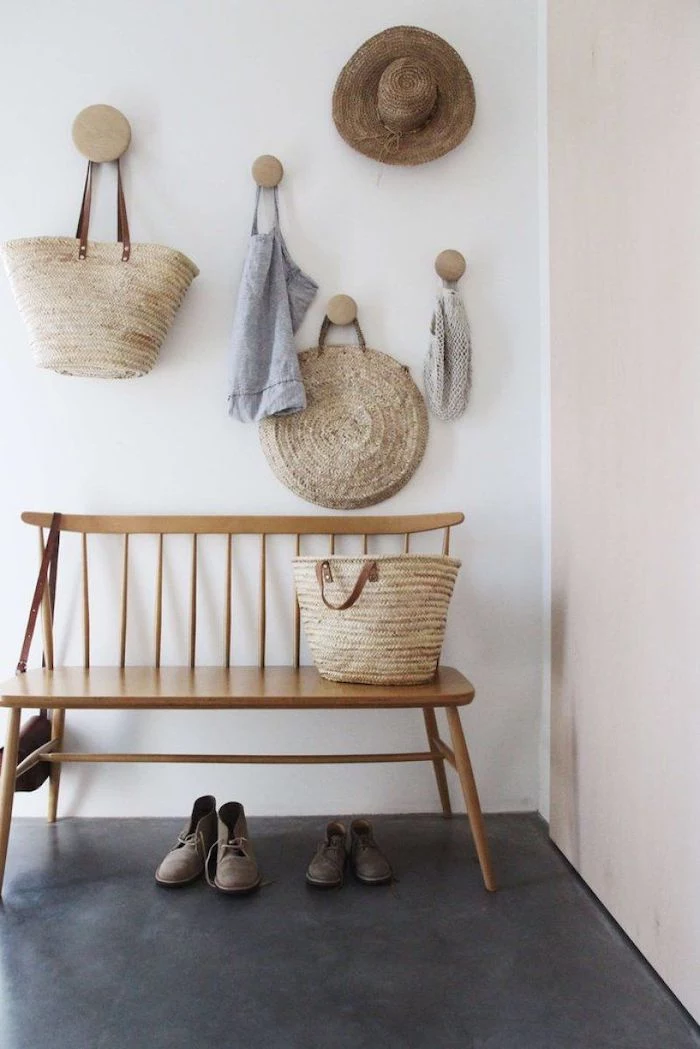
Don’t be afraid of the dark: While light paints are a safe bet, a deep, moody color like Farrow & Ball’s ‘Hague Blue’ or ‘Down Pipe’ can be magical. In a long hallway, painting the far end wall a dark shade creates an optical illusion, making the space feel wider and drawing you forward with a sense of drama and intimacy.
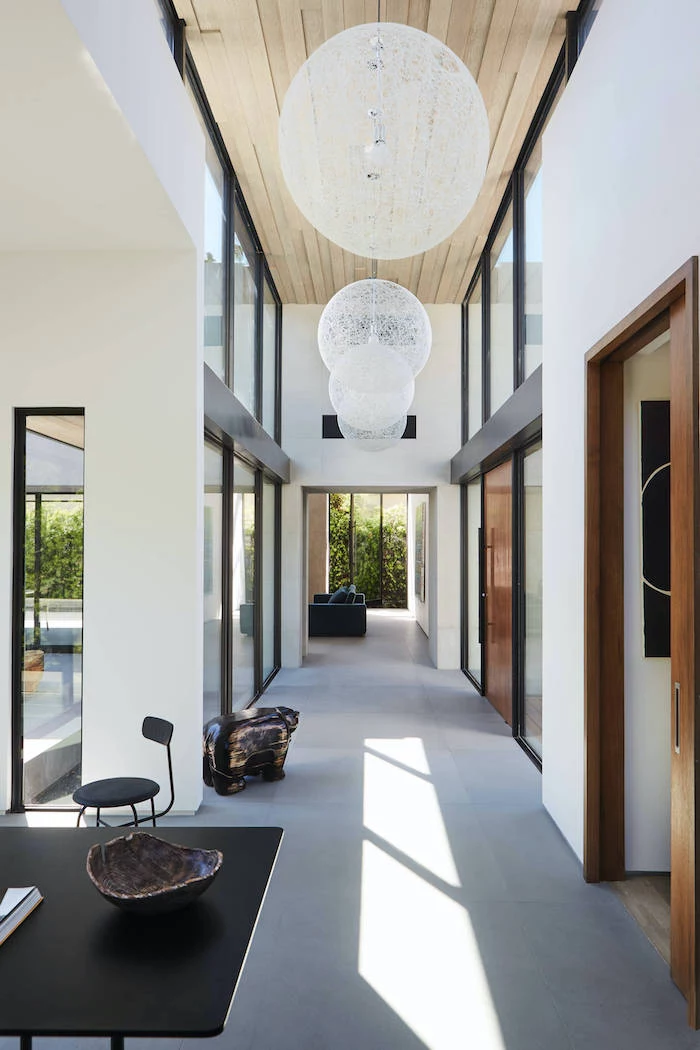
Think beyond the console table for storage. A row of stylish, wall-mounted cabinets (like the IKEA EKET series) can float above the floor, providing hidden storage for shoes, bags, and winter gear without taking up precious floor space. This keeps the sightline clear and makes the hallway feel much larger.
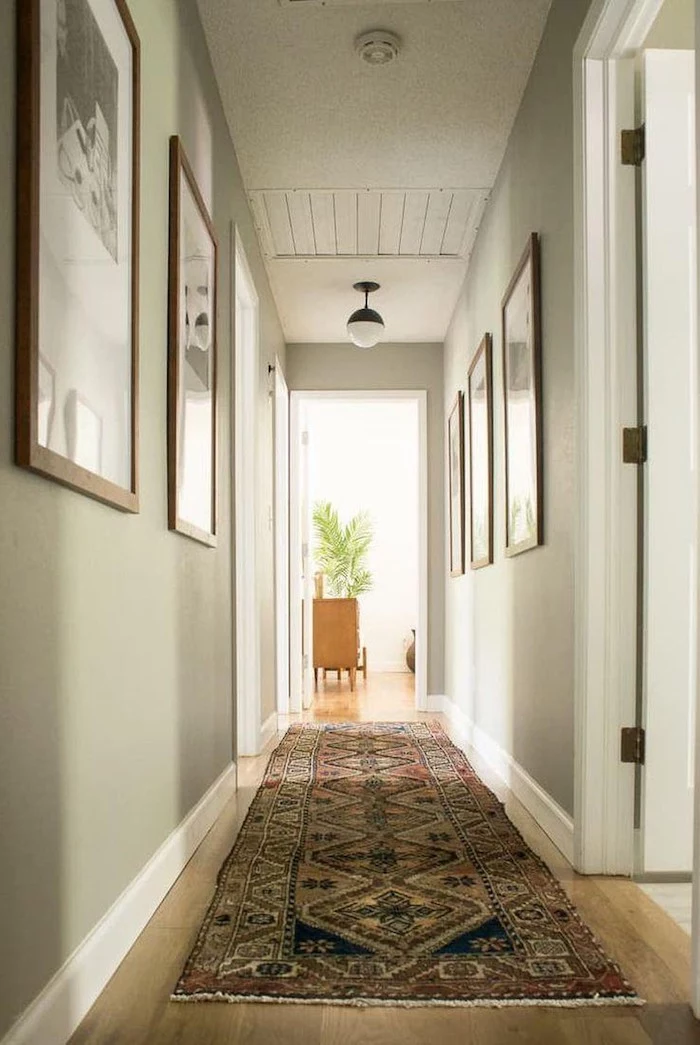
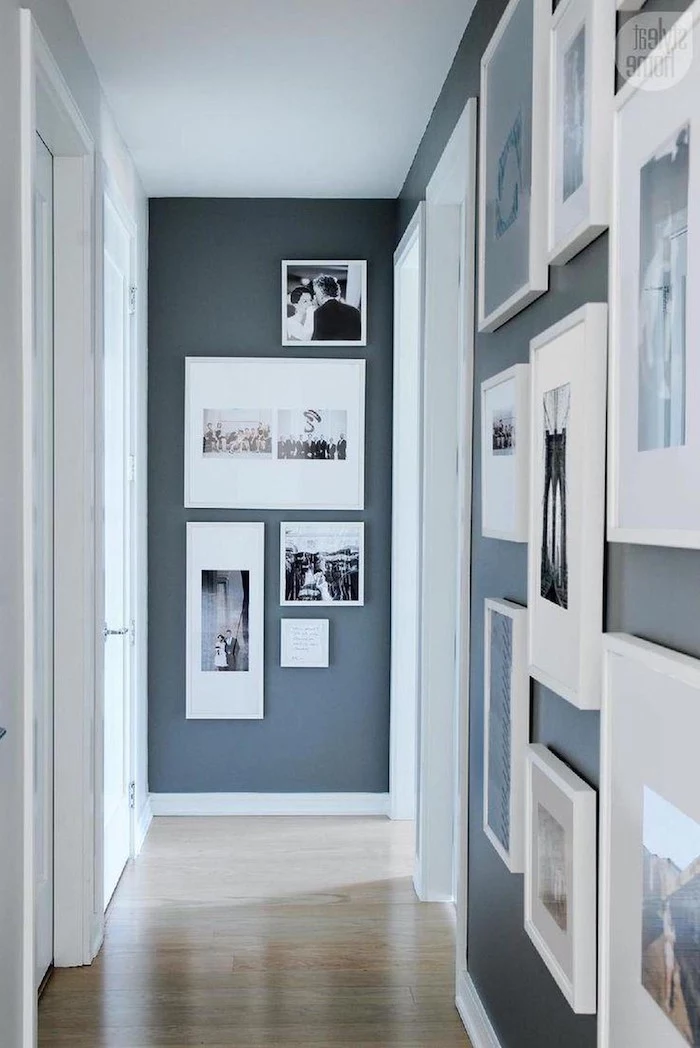
To add character without overwhelming the space, try this professional trick:
- Apply a bold wallpaper to the ceiling instead of the walls.
- Paint the walls a coordinating, neutral color pulled from the wallpaper pattern.
This draws the eye up, adds a surprising design element, and makes the room feel taller without visually narrowing the walls.
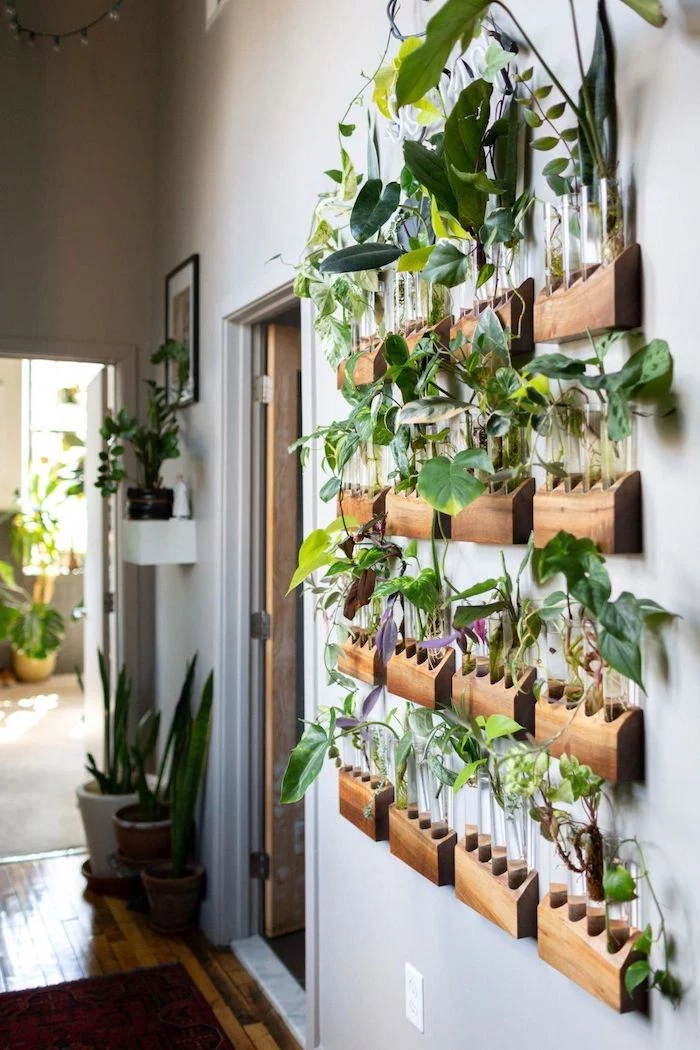
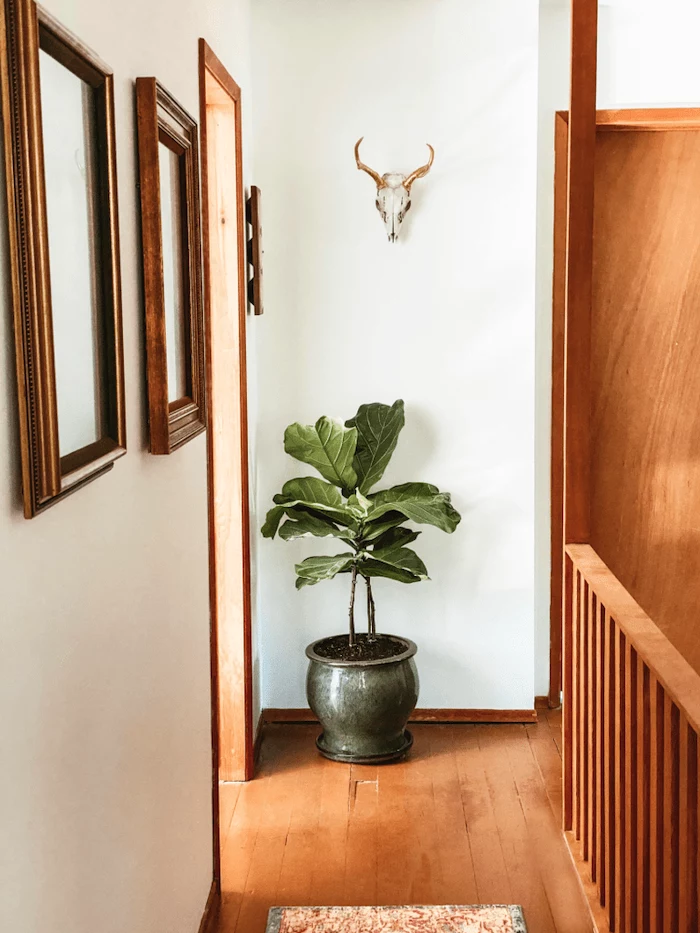
Did you know that a single can of paint is often cited by designers as the most cost-effective way to completely transform a space?
For a hallway, this is doubly true. A fresh coat in a well-chosen color can redefine the entire home’s atmosphere for less than the cost of a new rug. For a weekend project with maximum impact, it’s unbeatable.
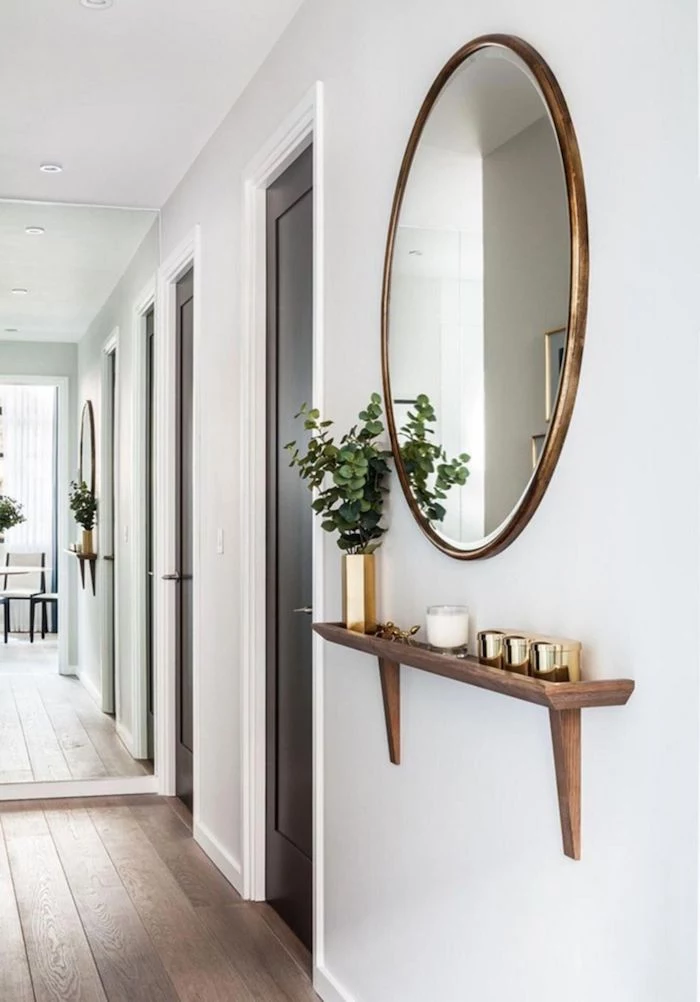
Does your hallway amplify every sound in the house?
Hard surfaces bounce sound waves, creating an echo chamber effect. The solution is to add soft materials. A thick wool runner, a fabric-covered bench, or even a large textile wall hanging can absorb sound, making the space feel quieter, calmer, and more serene.
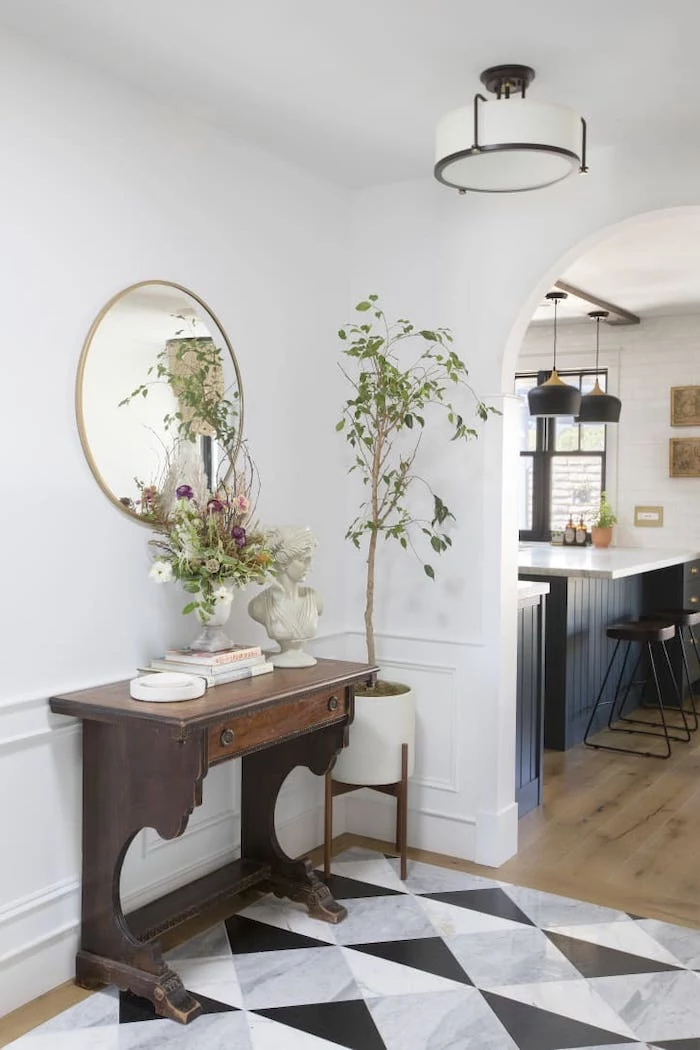
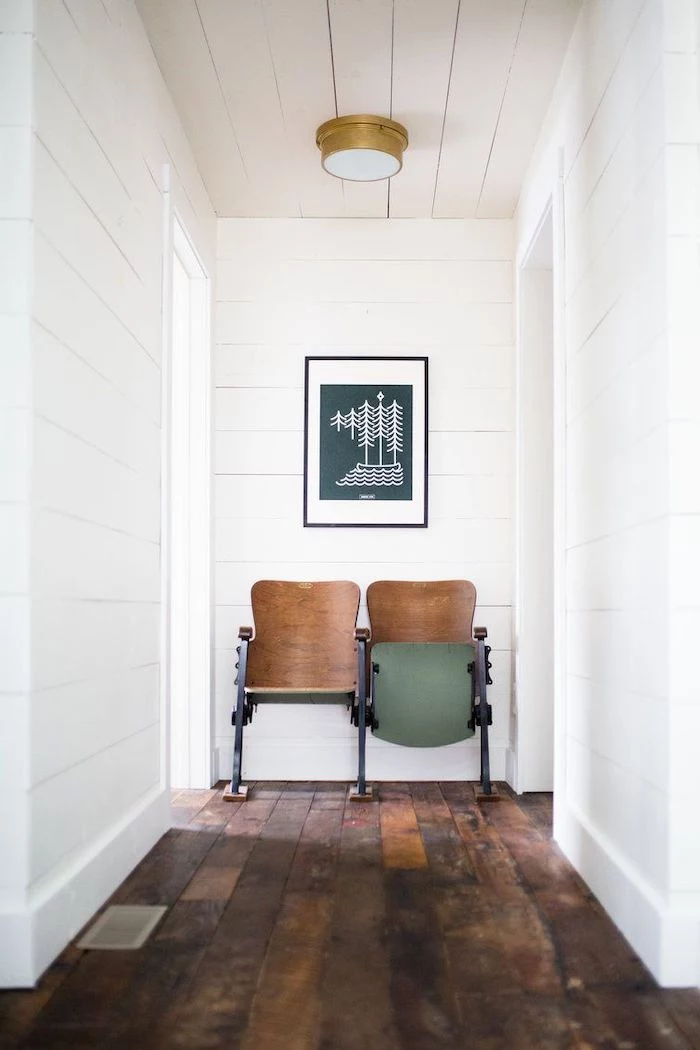
Wooden Slats: Adds warmth and a spa-like, contemporary feel. Can be a DIY project using simple lumber to create a stunning accent wall.
Pressed Tin Tiles: Offer vintage charm and intricate texture. They are lightweight and relatively easy to install for an old-world look.
Both options create a powerful focal point and solve the
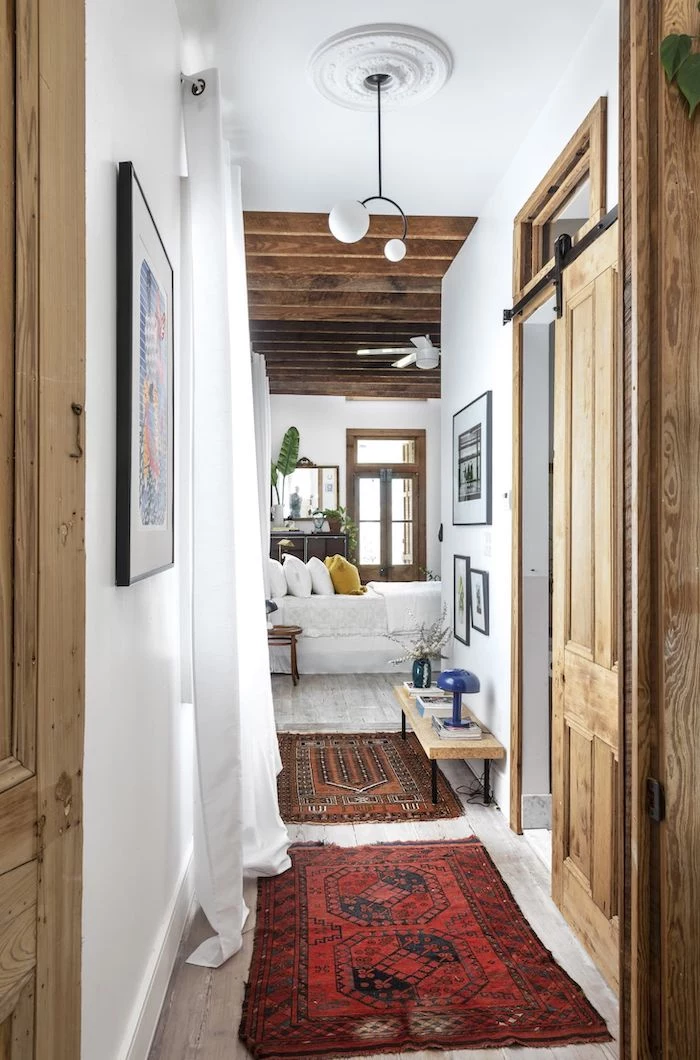
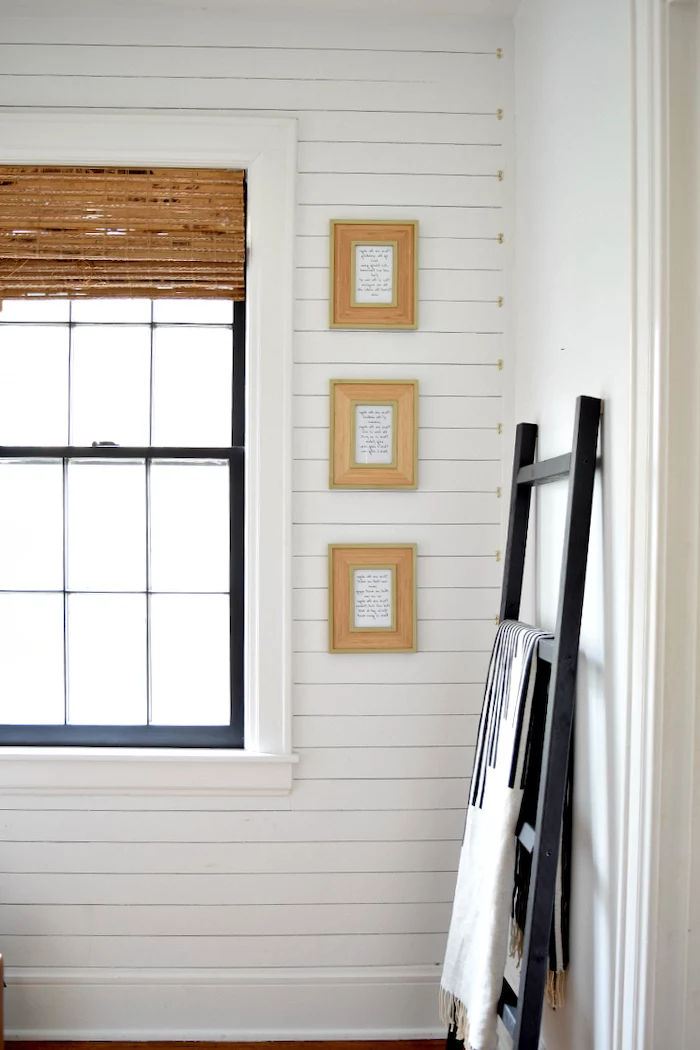
One of the biggest trends in furniture design right now is fluted or reeded detailing. A console table or cabinet with this textured, vertical pattern adds instant sophistication and tactile interest to a hallway. It’s a subtle nod to Art Deco glamour but feels entirely modern. Check out pieces from West Elm or Crate & Barrel to see this trend in action.
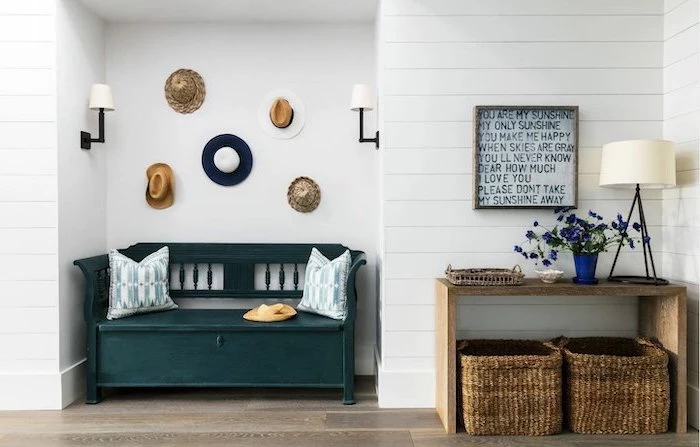
- It feels more balanced and professional.
- It relates the art to the human scale of the room, not the ceiling height.
- It ensures a consistent, museum-quality look for a gallery wall.
Why do designers insist on hanging art with its center 57 inches from the floor? This is the average human eye level.
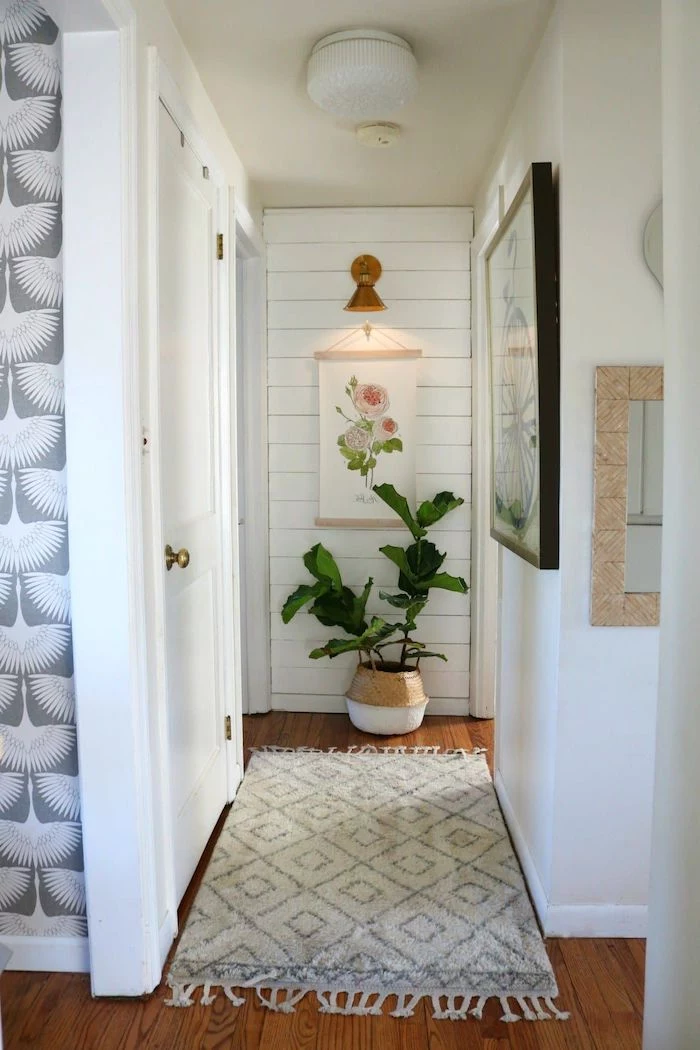
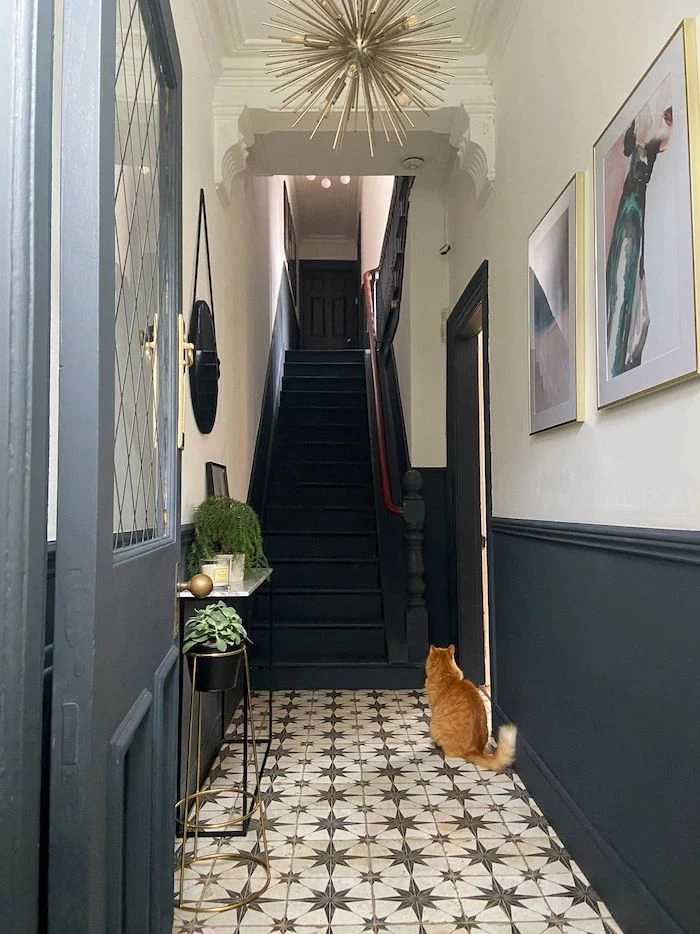
A welcoming touch: A narrow bench isn’t just for putting on shoes. It’s a design gesture that invites a pause. It says,
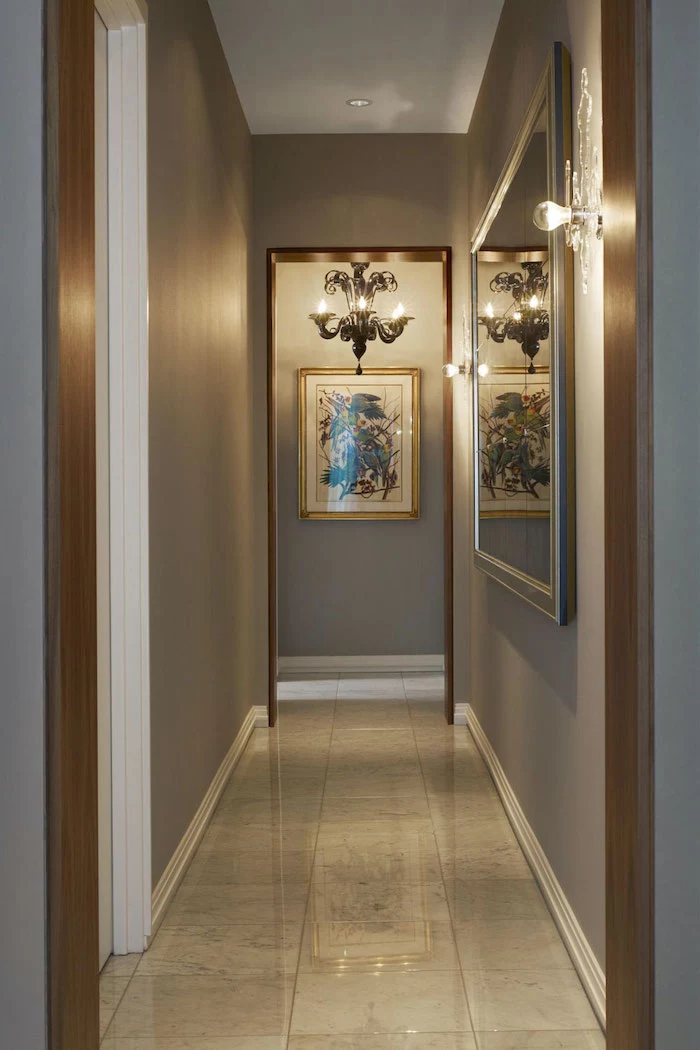
What can we learn from Japanese entryways?
The
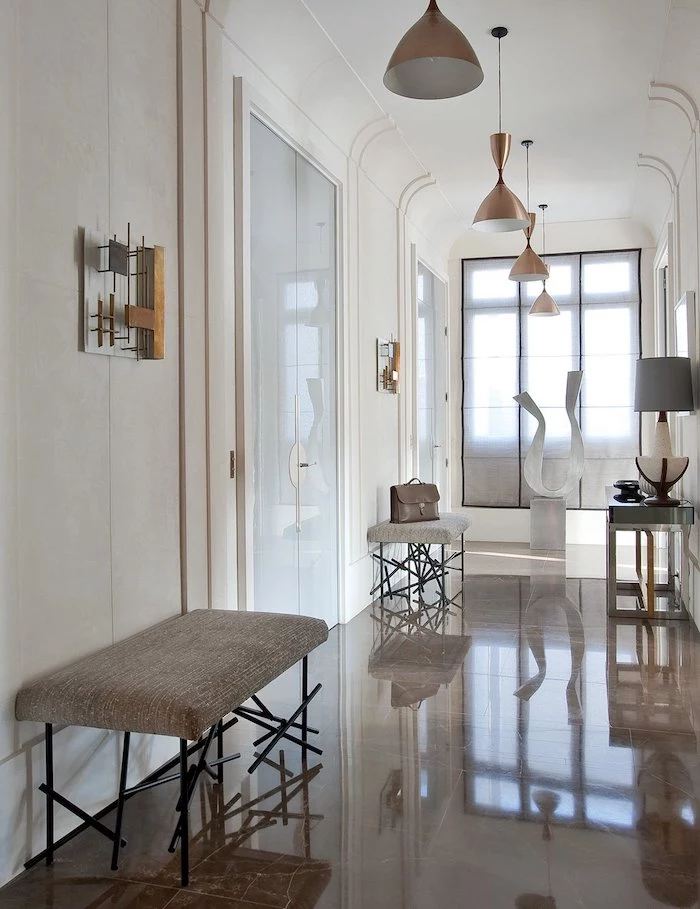
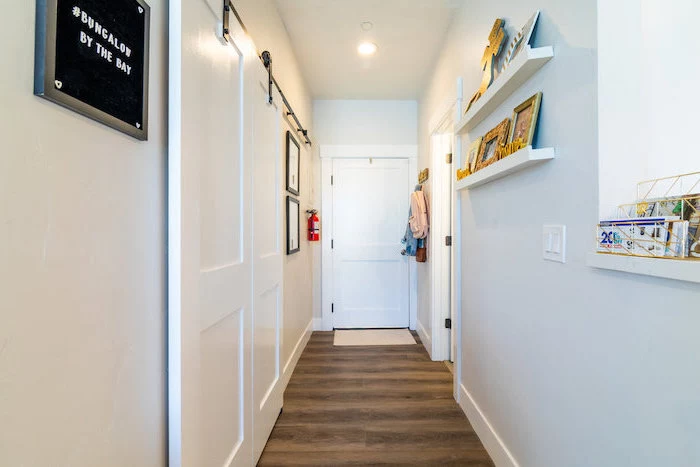
- Opt for a high-quality wool or polypropylene rug, as these materials are known for their durability and stain resistance in high-traffic areas.
- Avoid viscose or silk rugs, which are beautiful but too delicate for a hallway’s wear and tear.
- A flatweave rug is easier to clean and won’t obstruct doors.
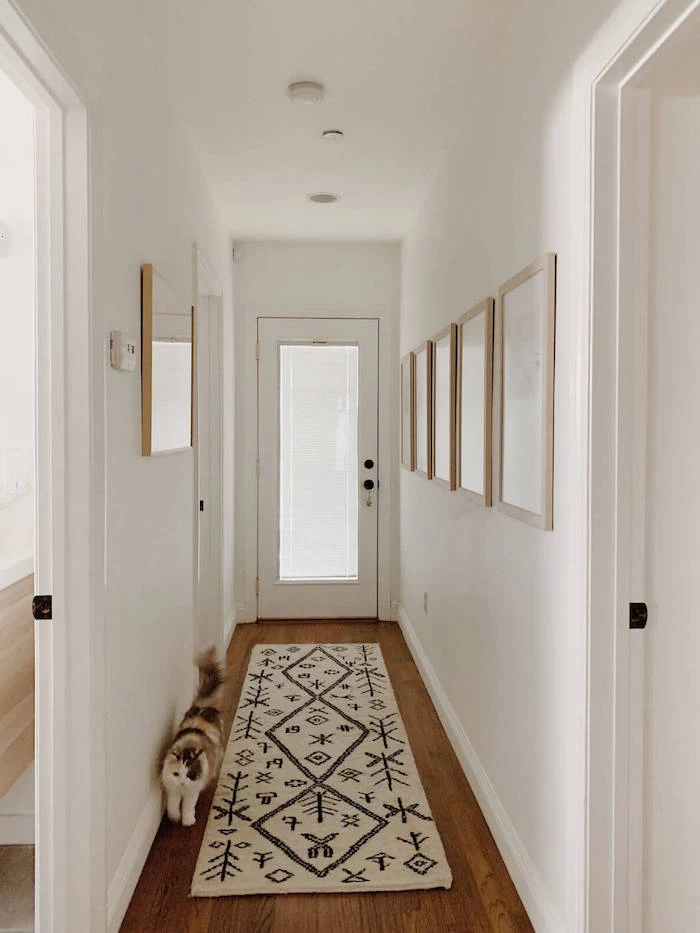
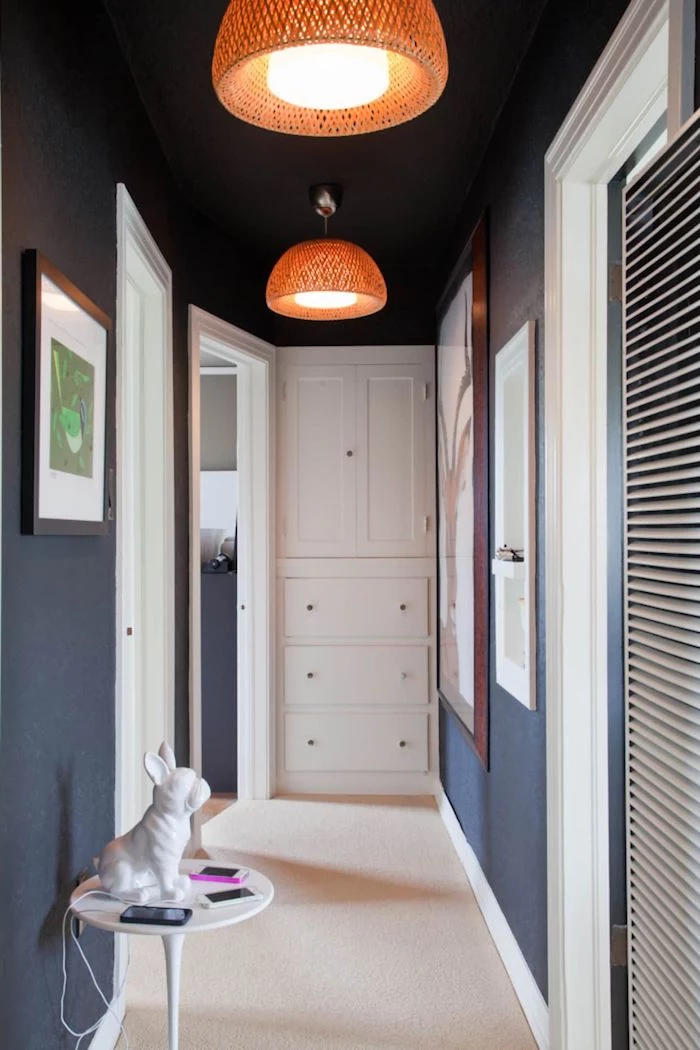
The International Residential Code doesn’t require outlets in hallways, but most electricians recommend placing one every 20-30 feet.
Don’t overlook this practical detail during a renovation. A strategically placed outlet is essential for a vacuum cleaner, a beautiful table lamp on a console, or even seasonal decorations. Planning for power from the start is a game-changer.
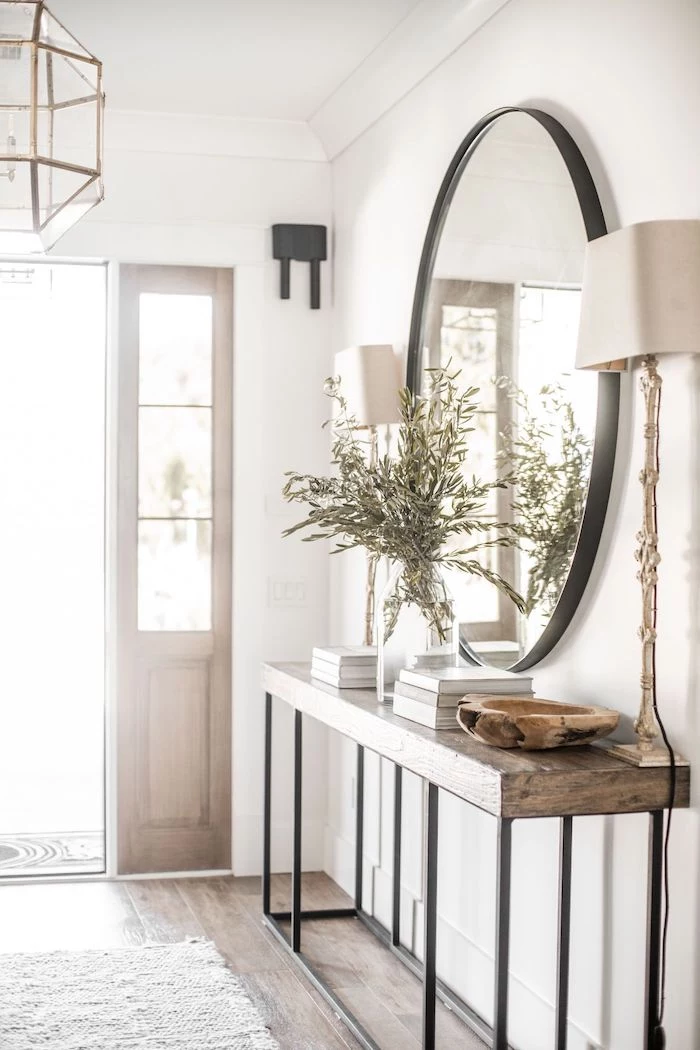
A digital art frame, like the Samsung
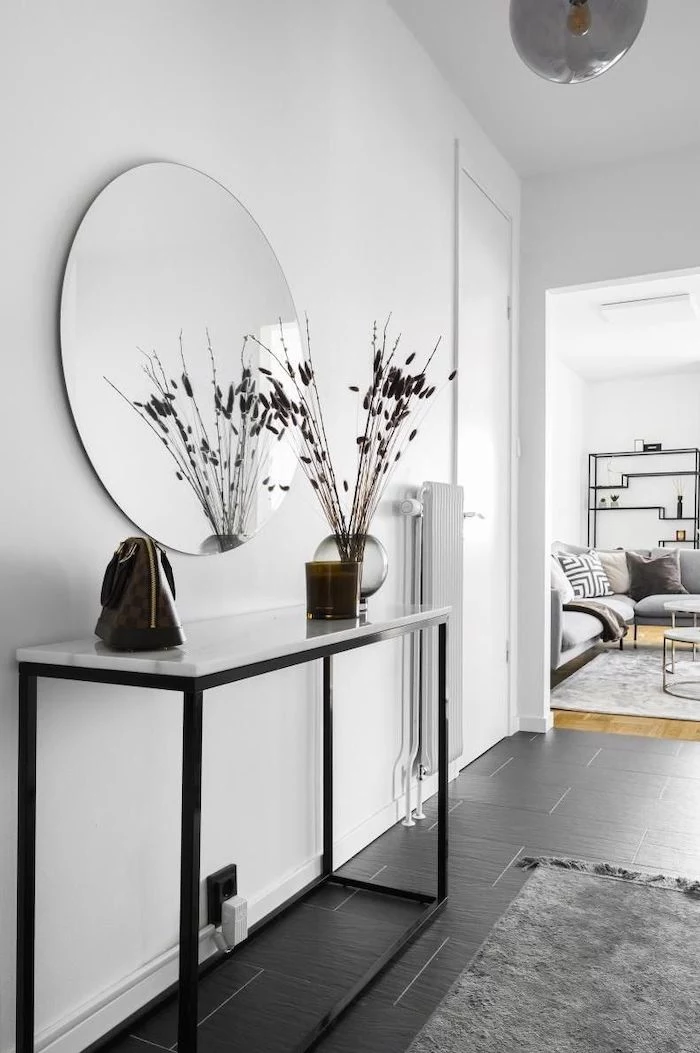
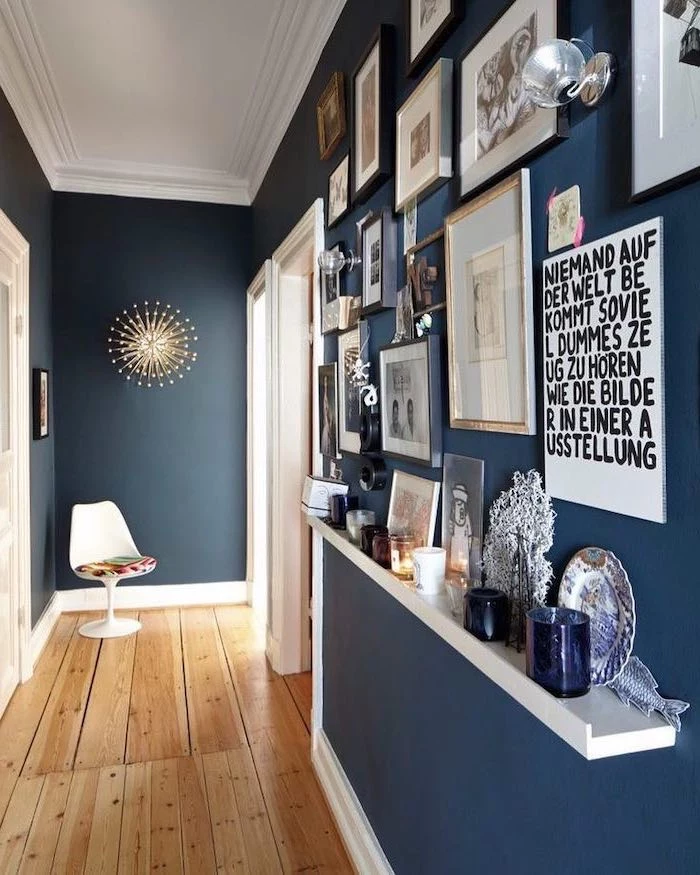
Victorian homes often featured elaborate geometric and encaustic floor tiles in their hallways, not just for beauty, but to signal the wealth and status of the owner to any visitor.
For an ultra-narrow hallway where even the slimmest console table won’t fit, think about a floating shelf. A simple, sturdy shelf from a brand like Shelfology or Rejuvenation, installed at table height, gives you a surface for keys and mail without taking up a single inch of floor space.






